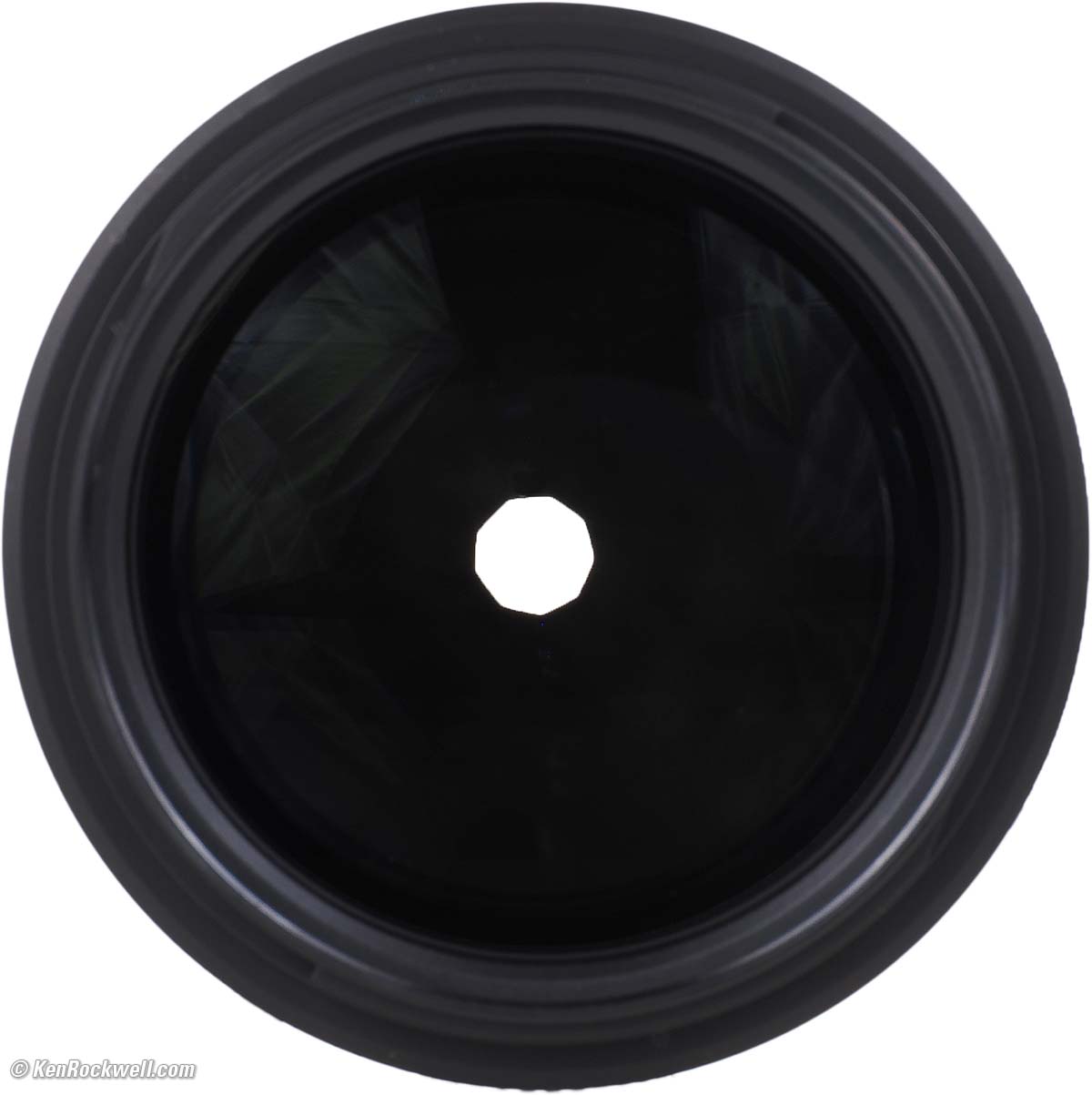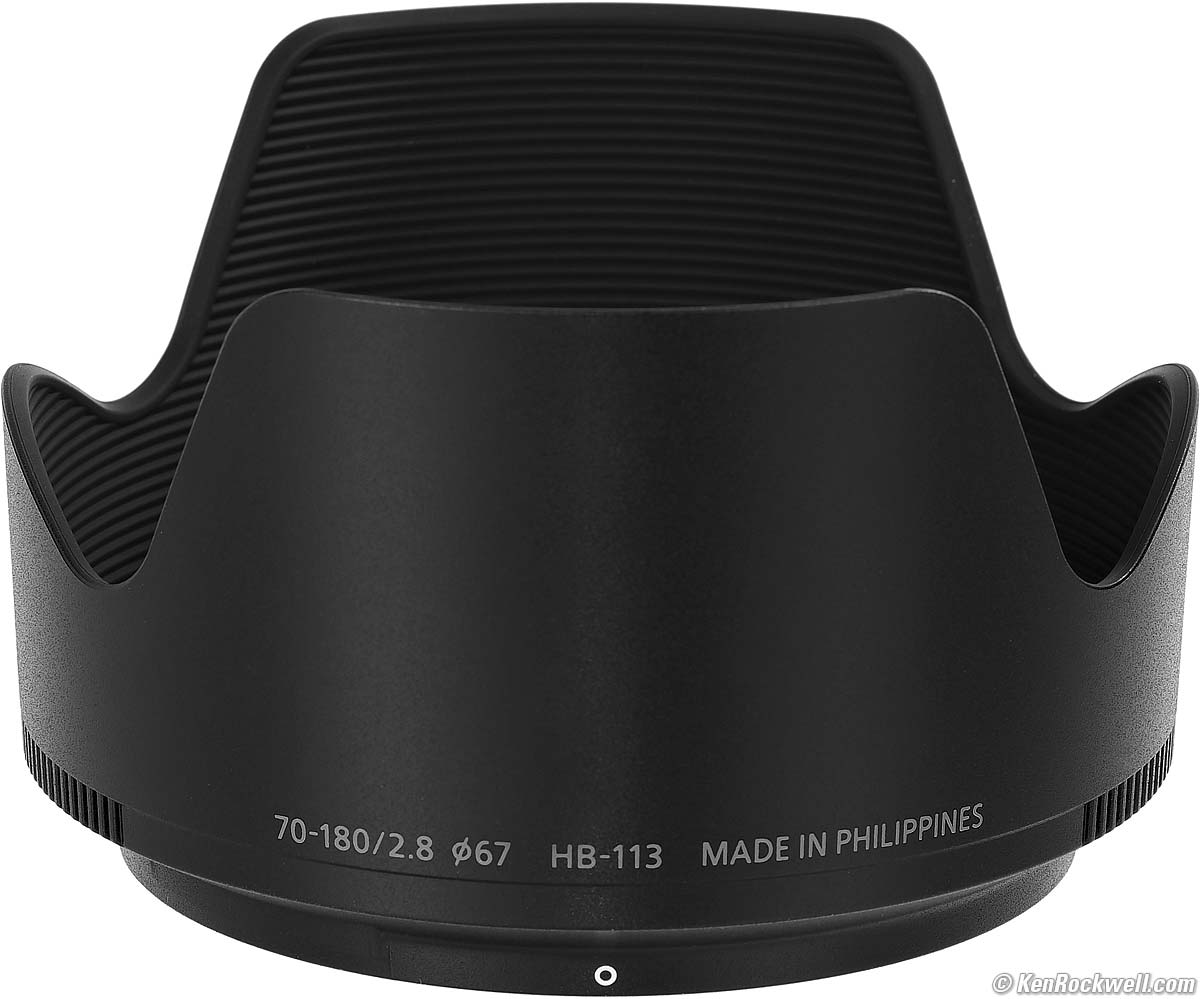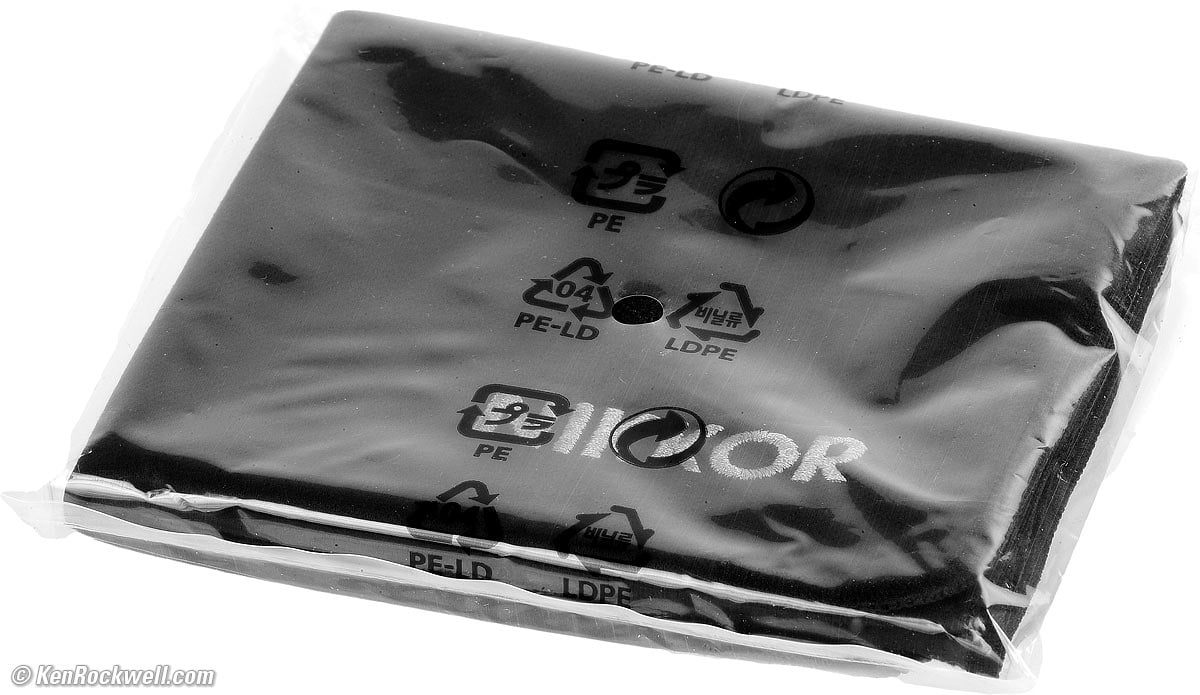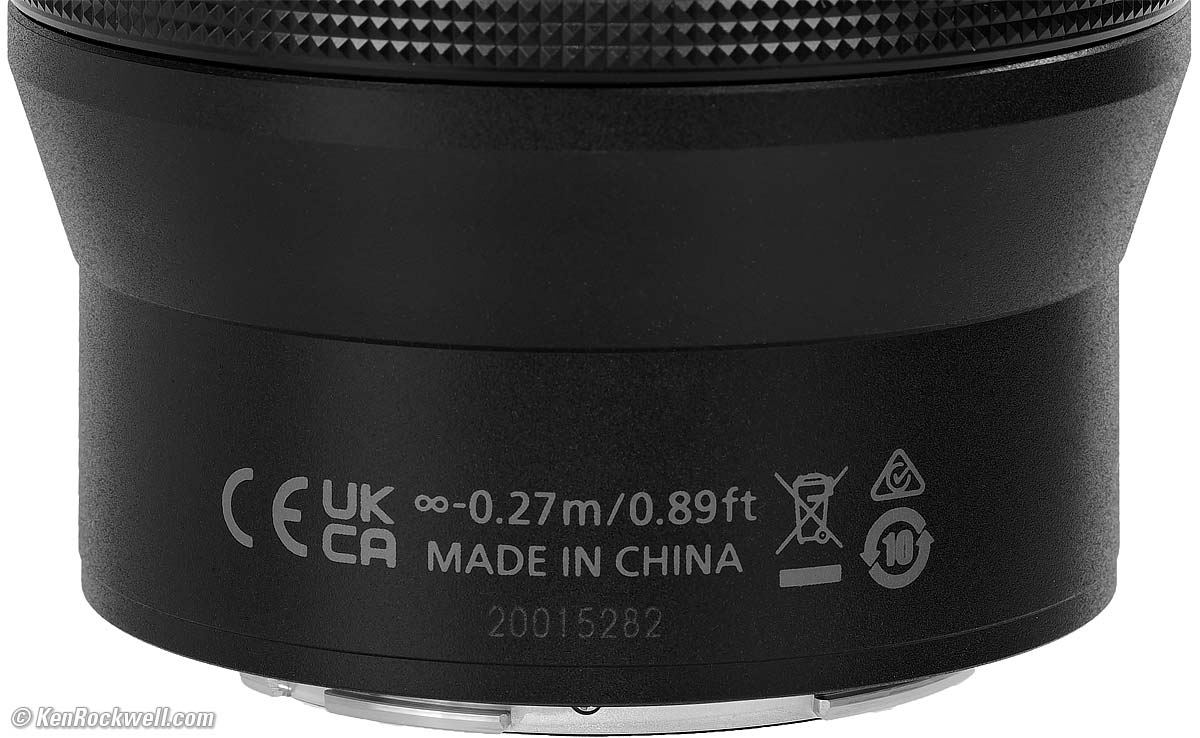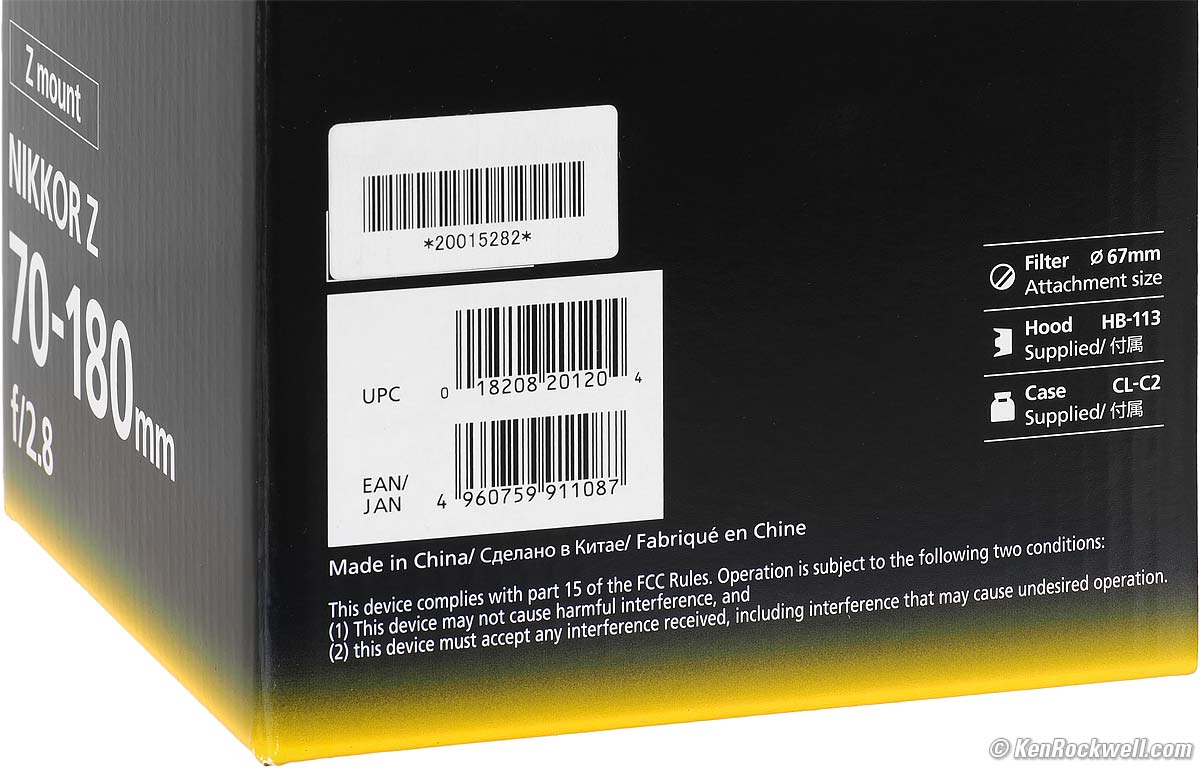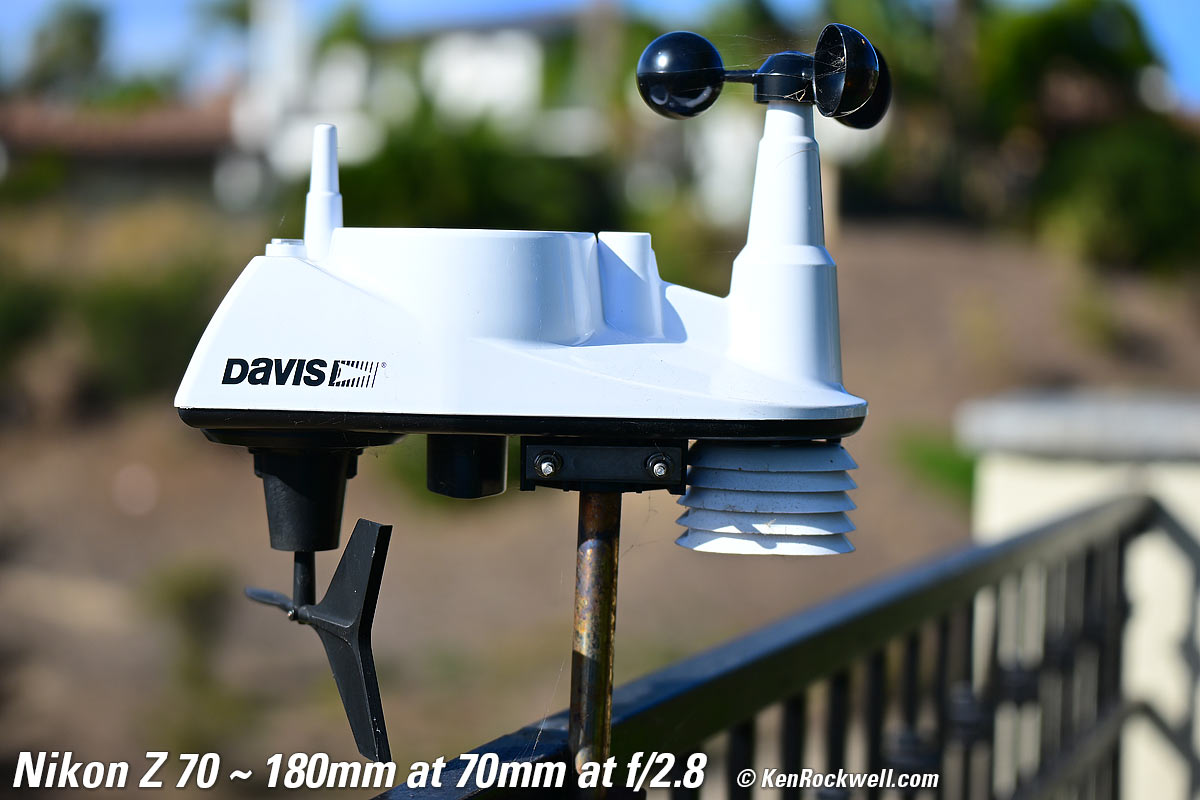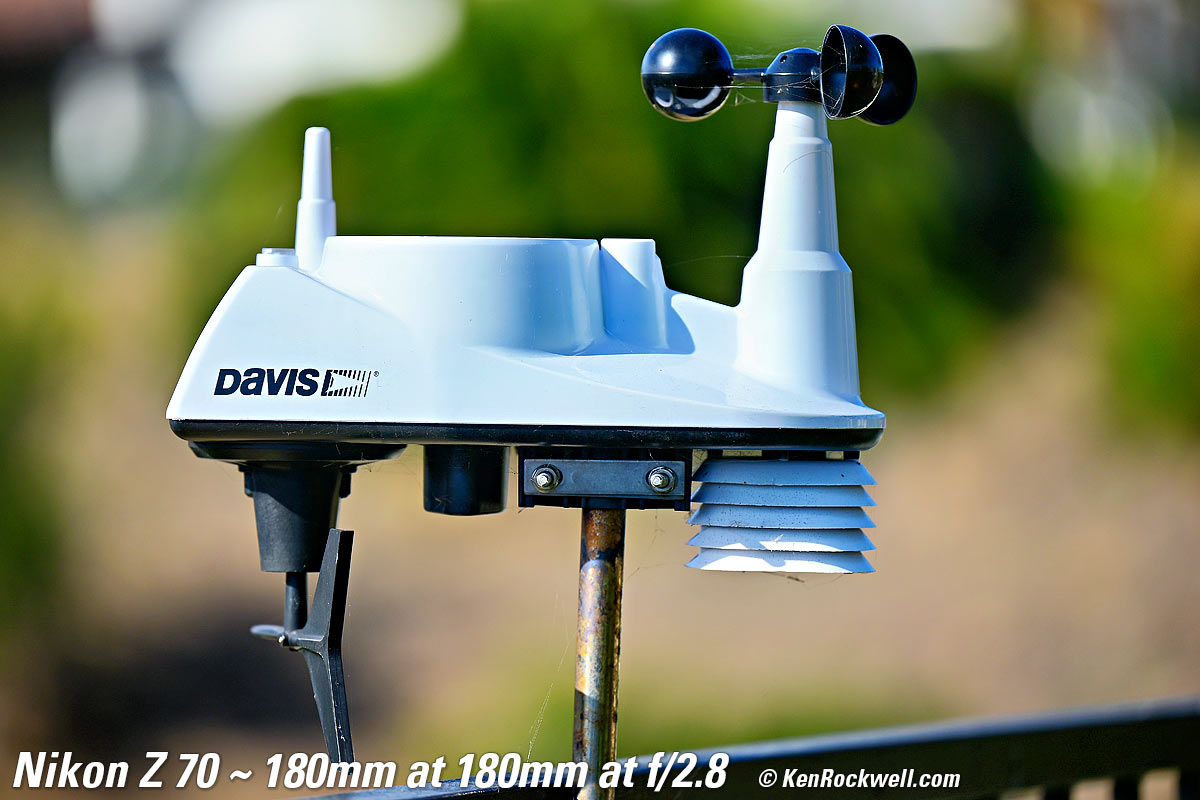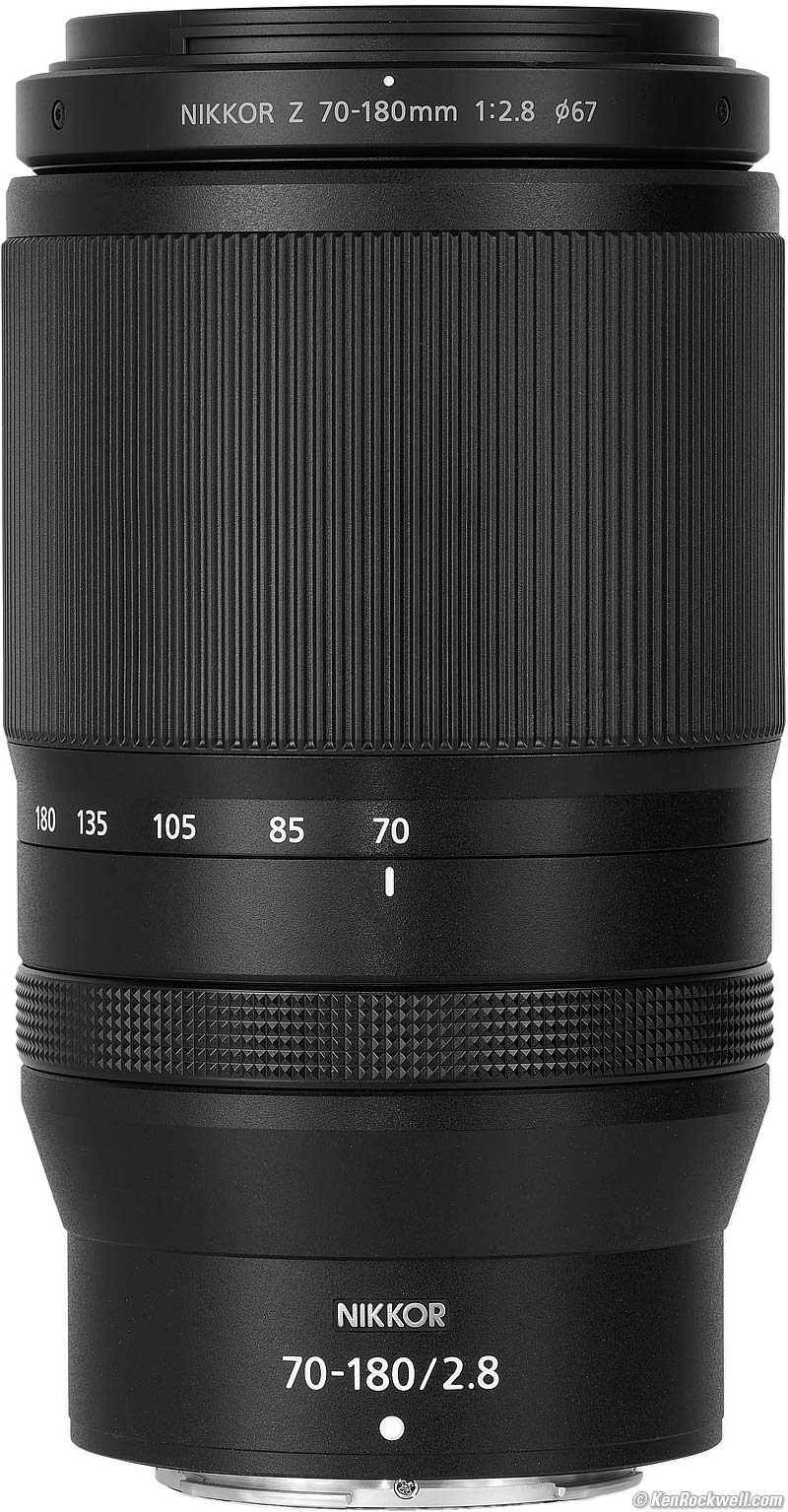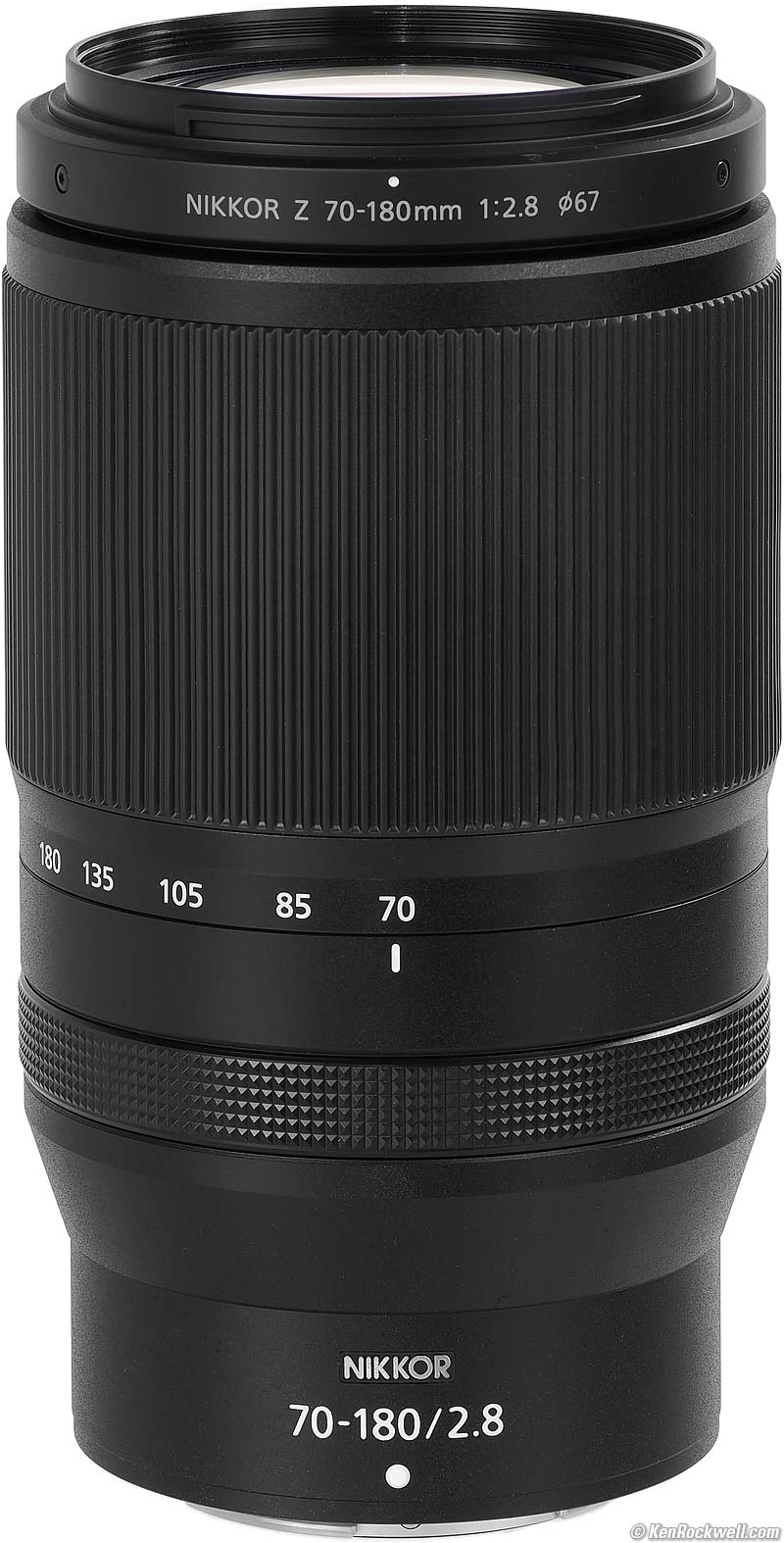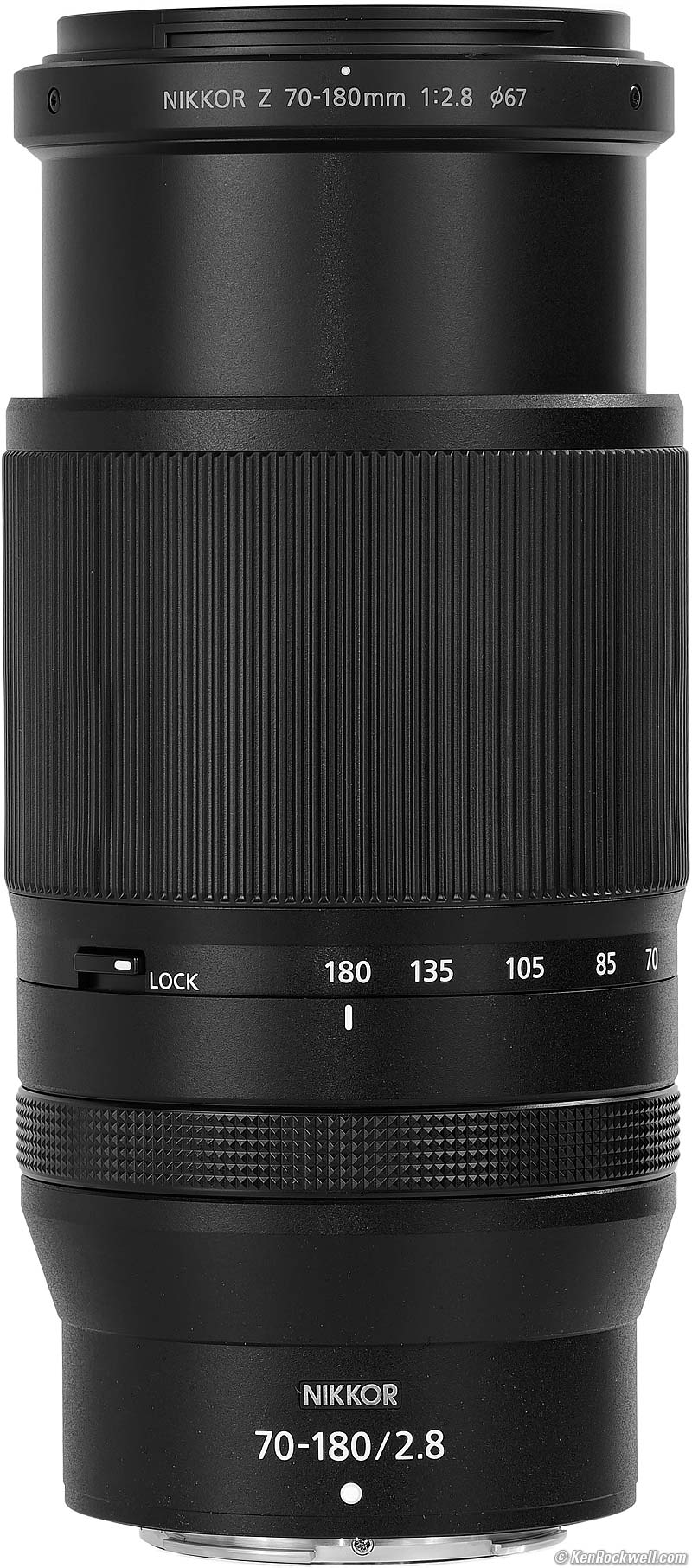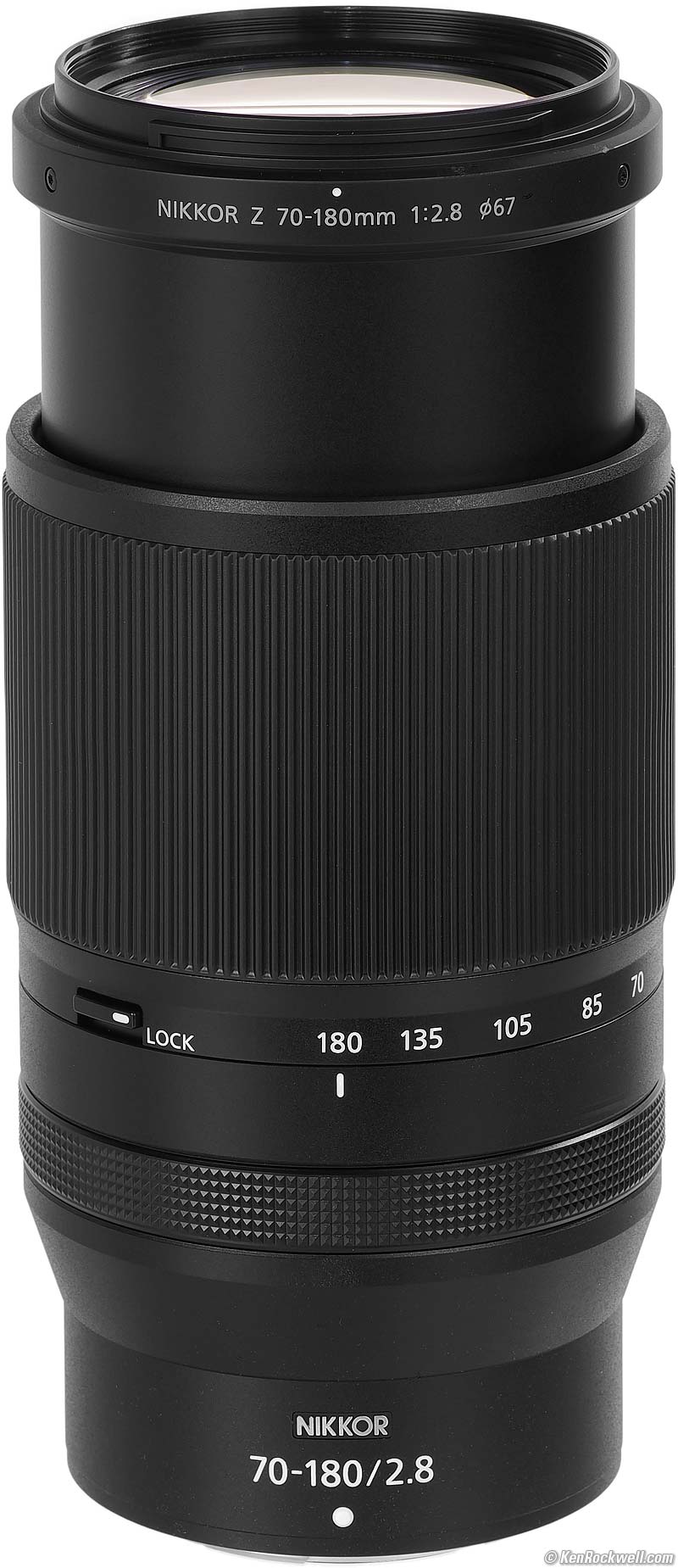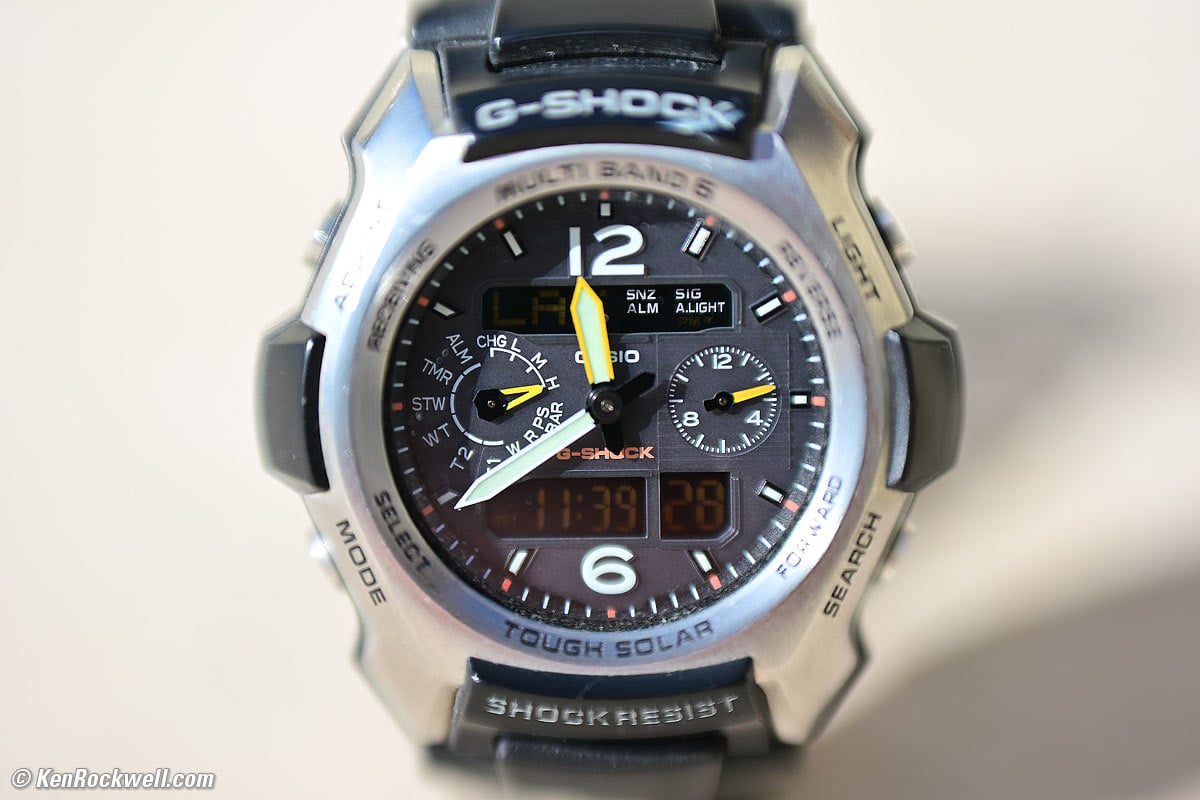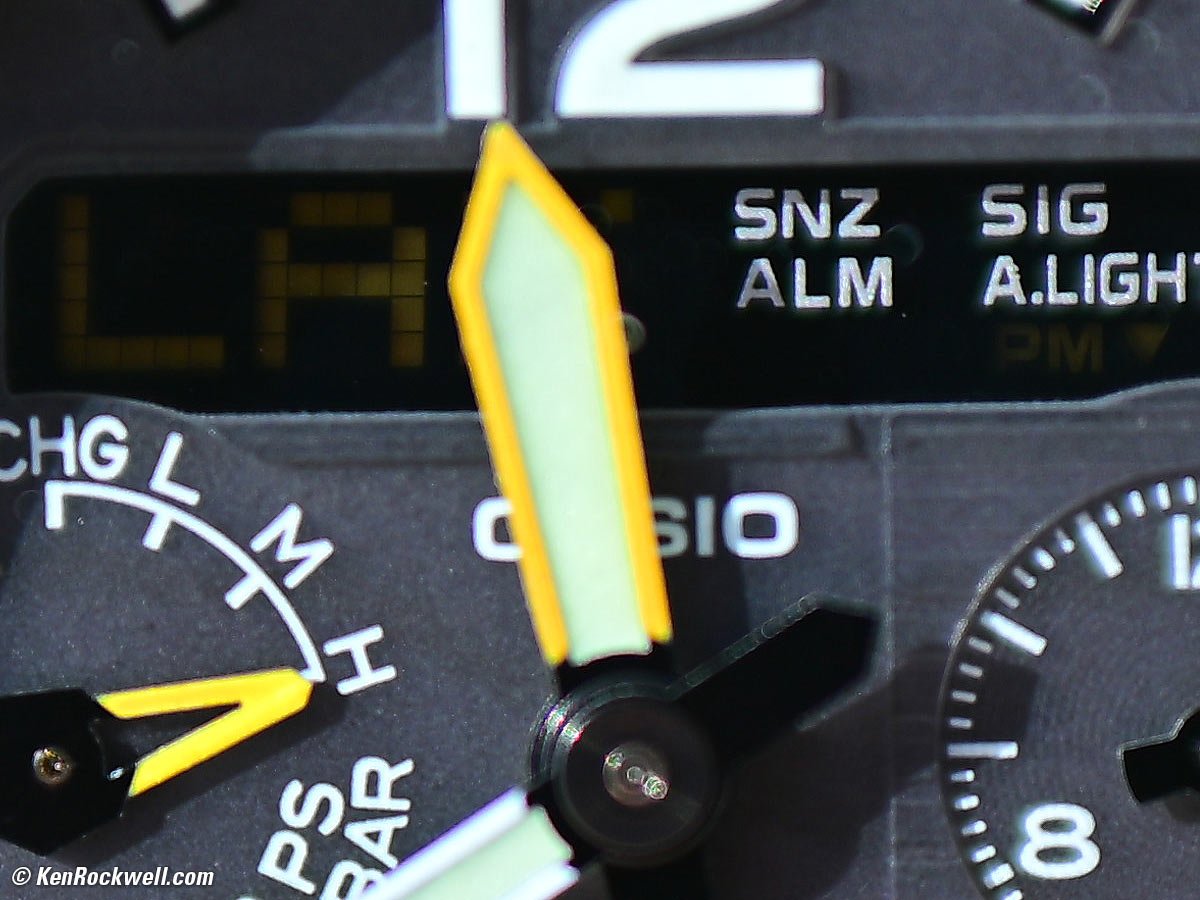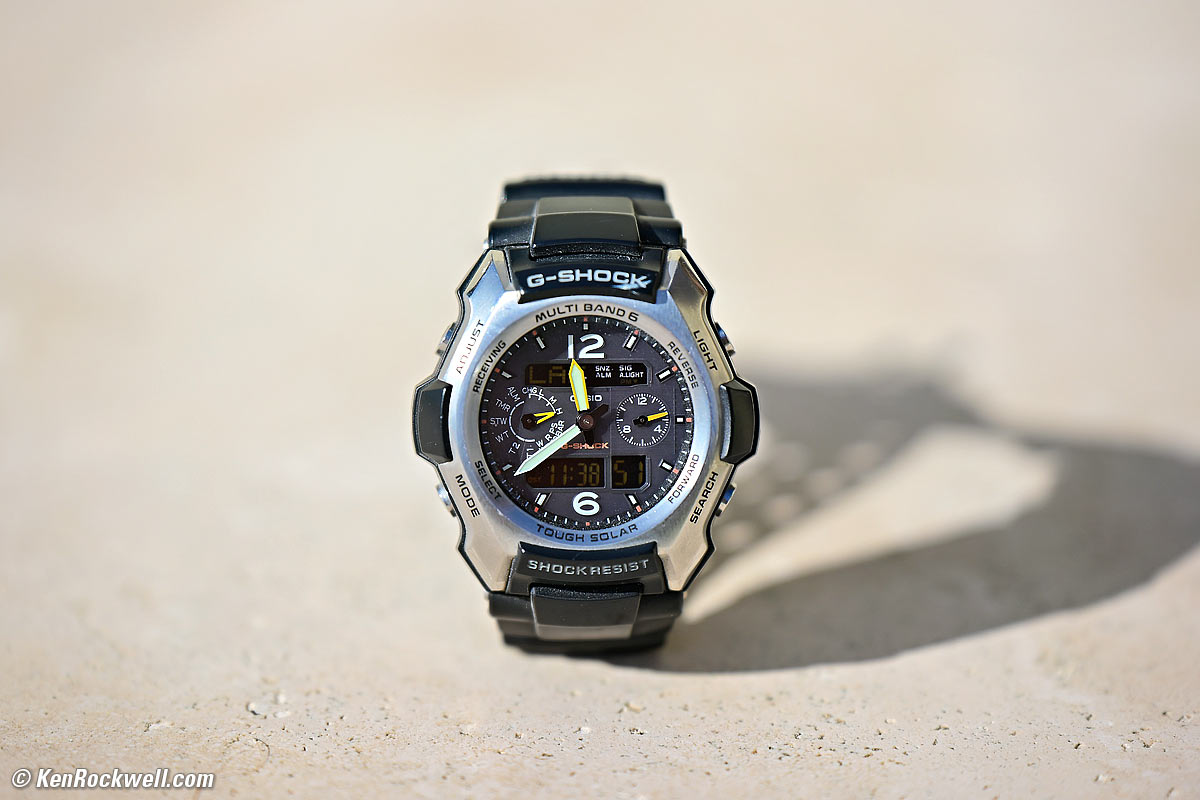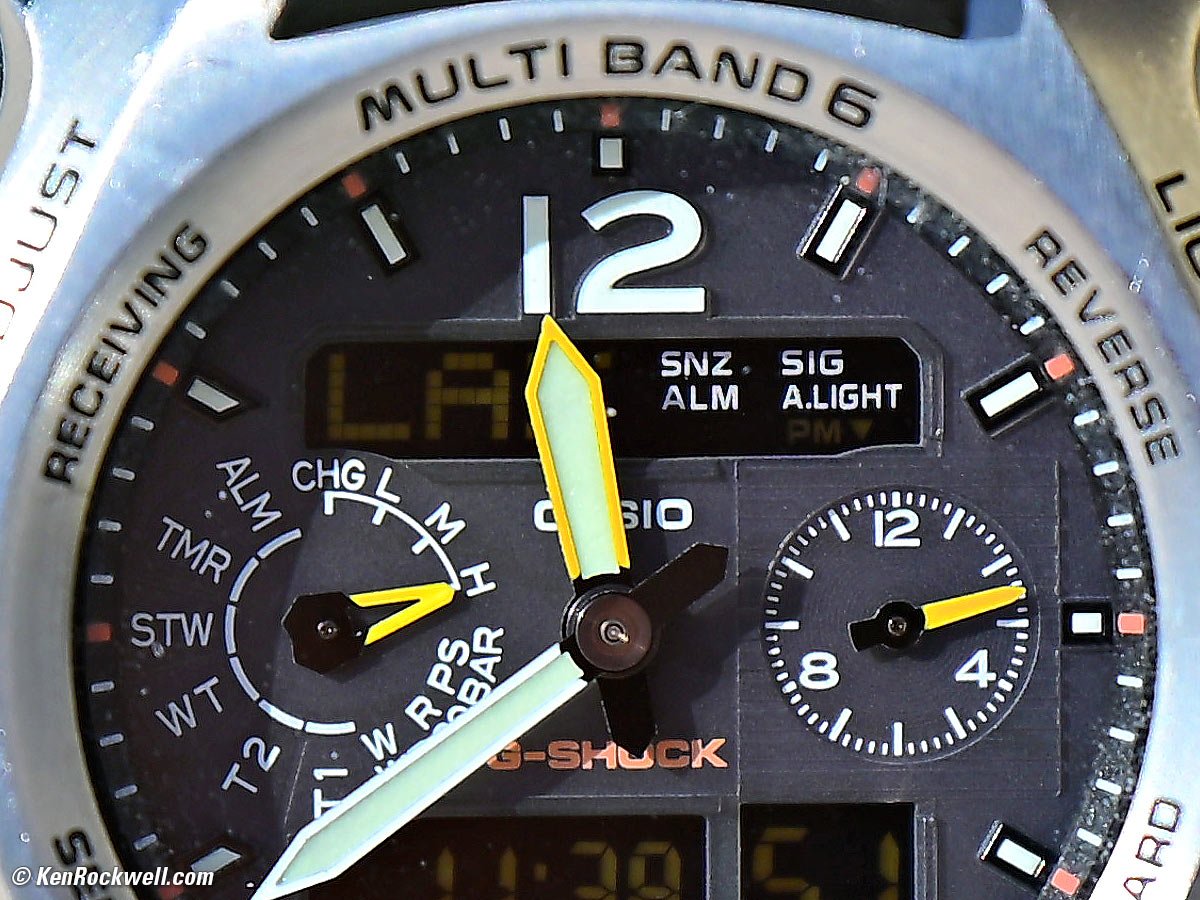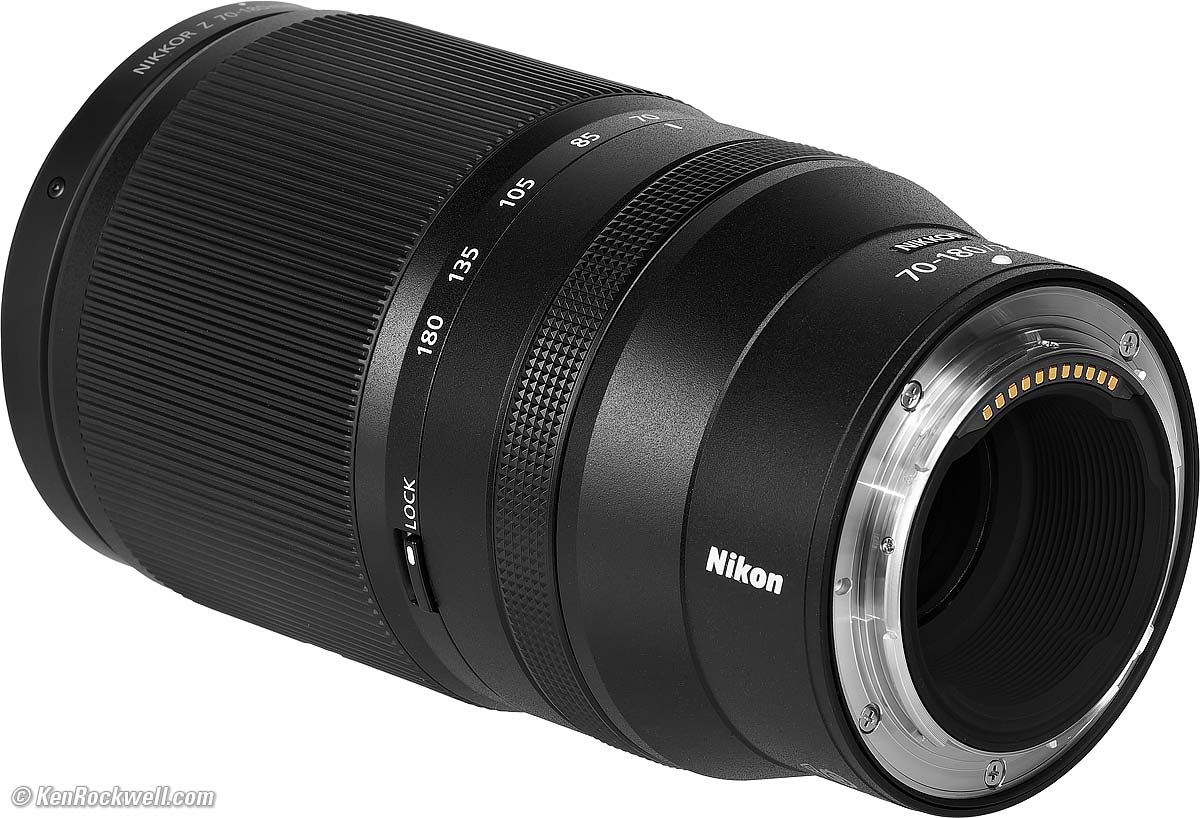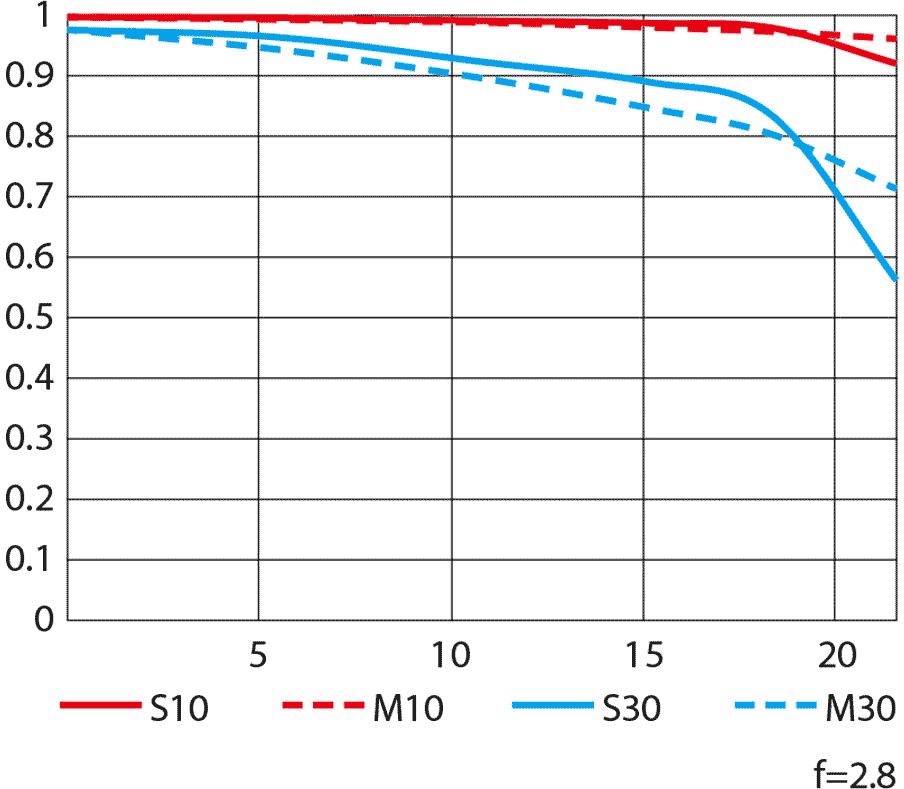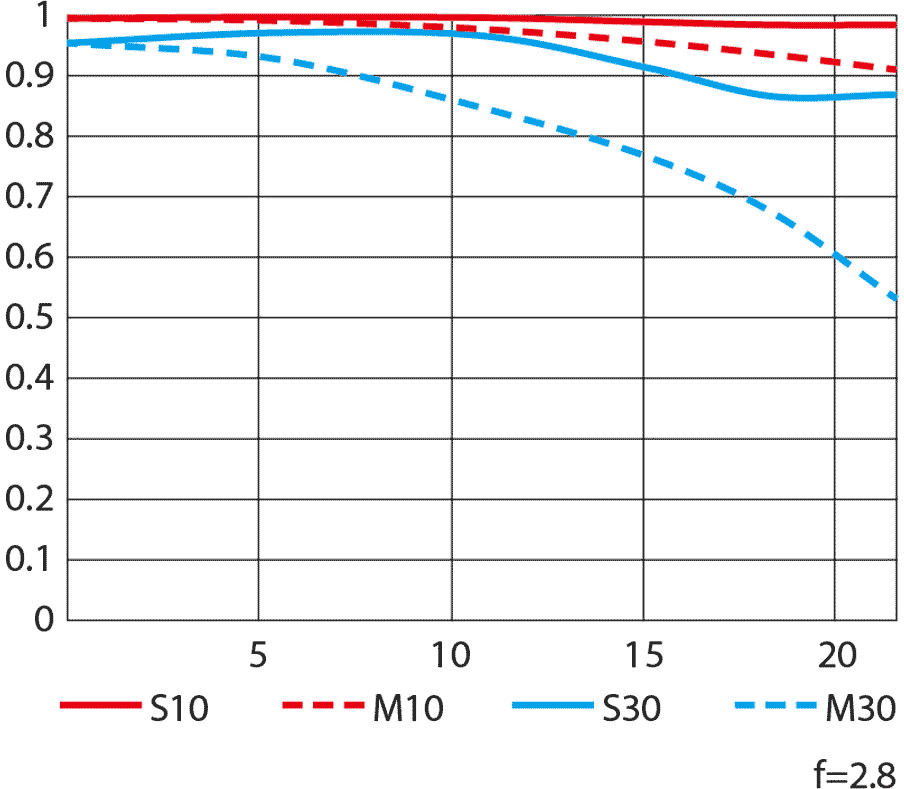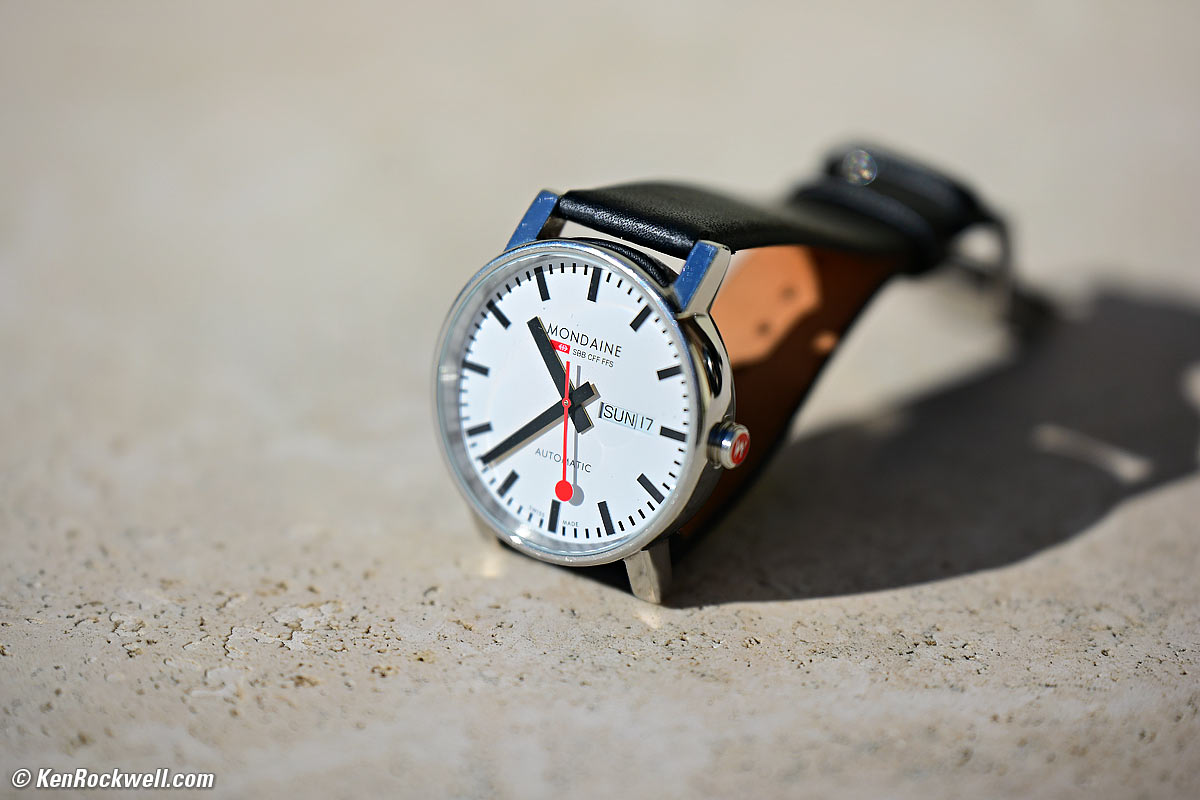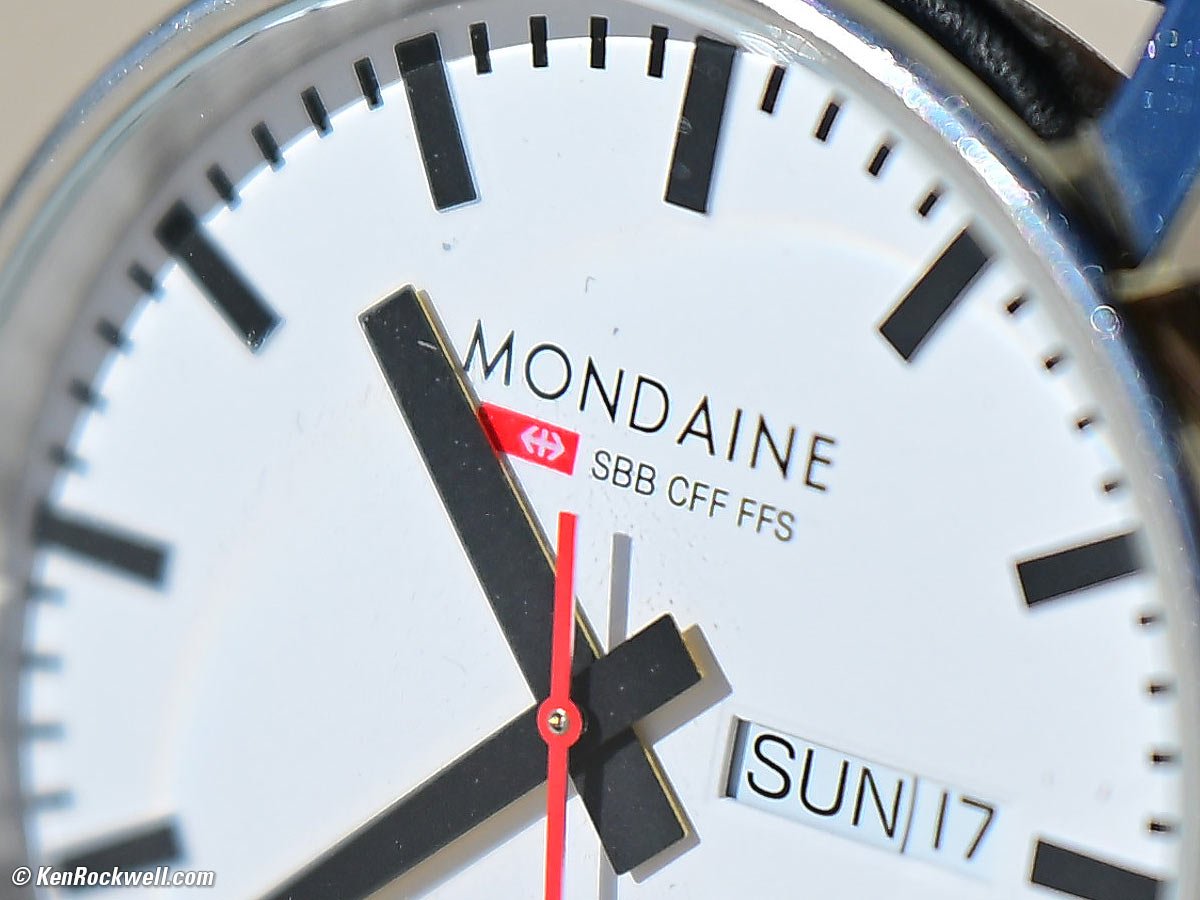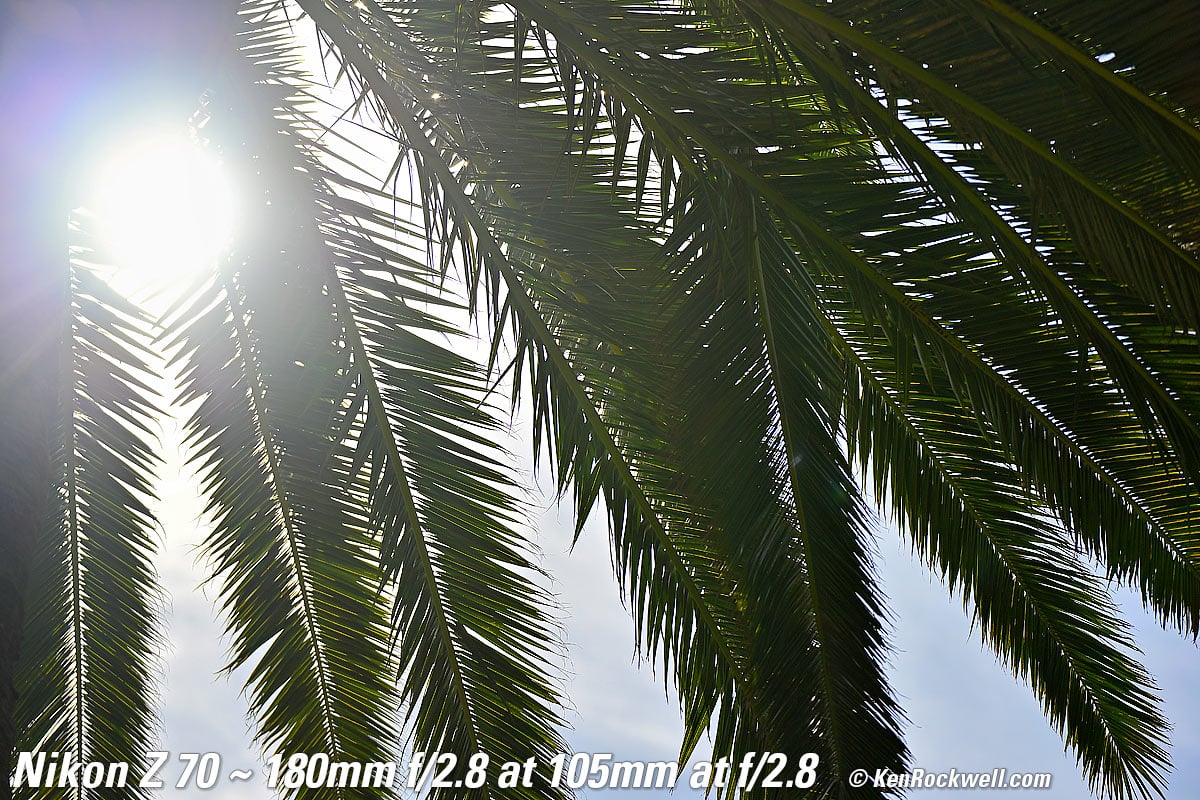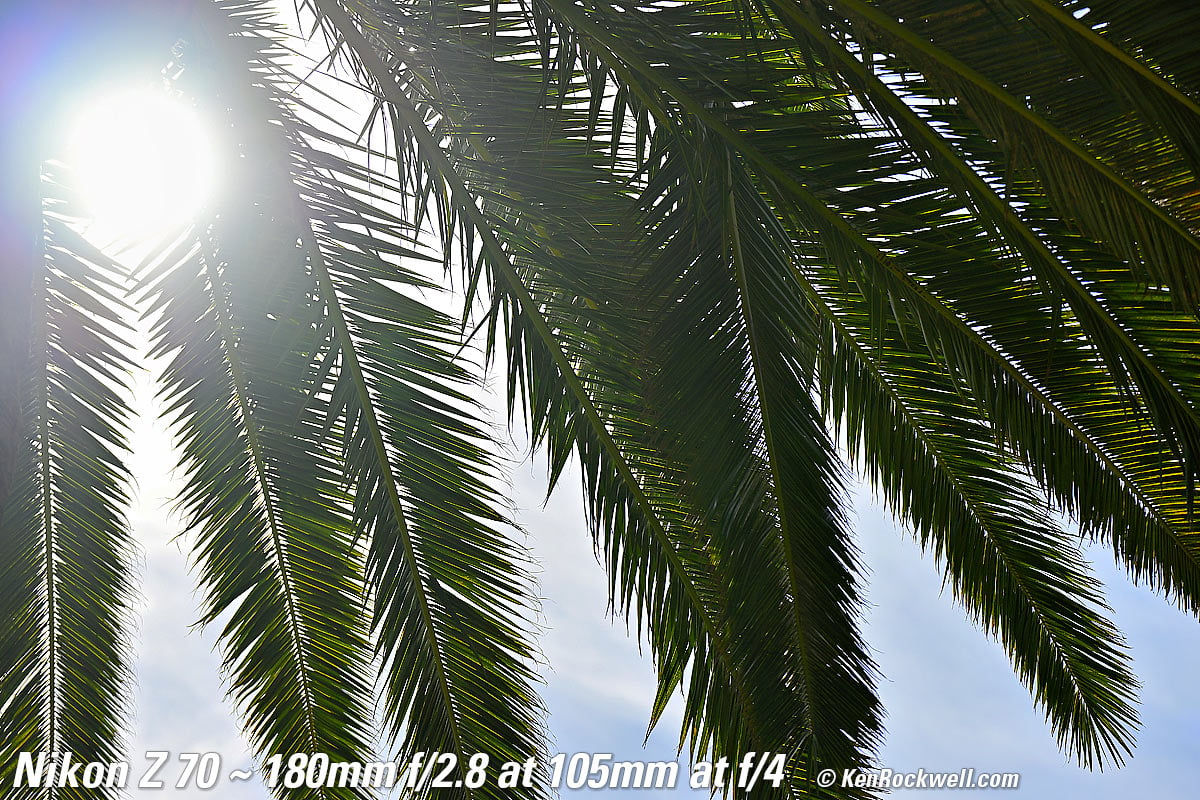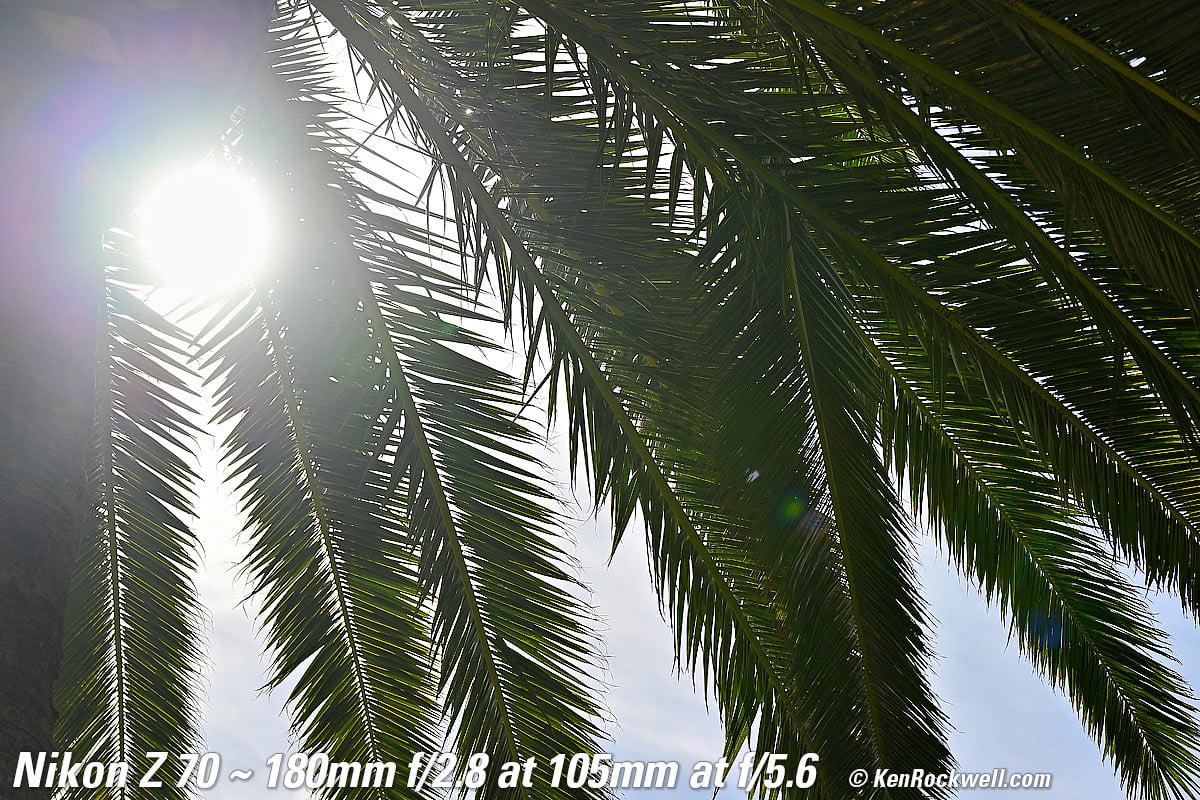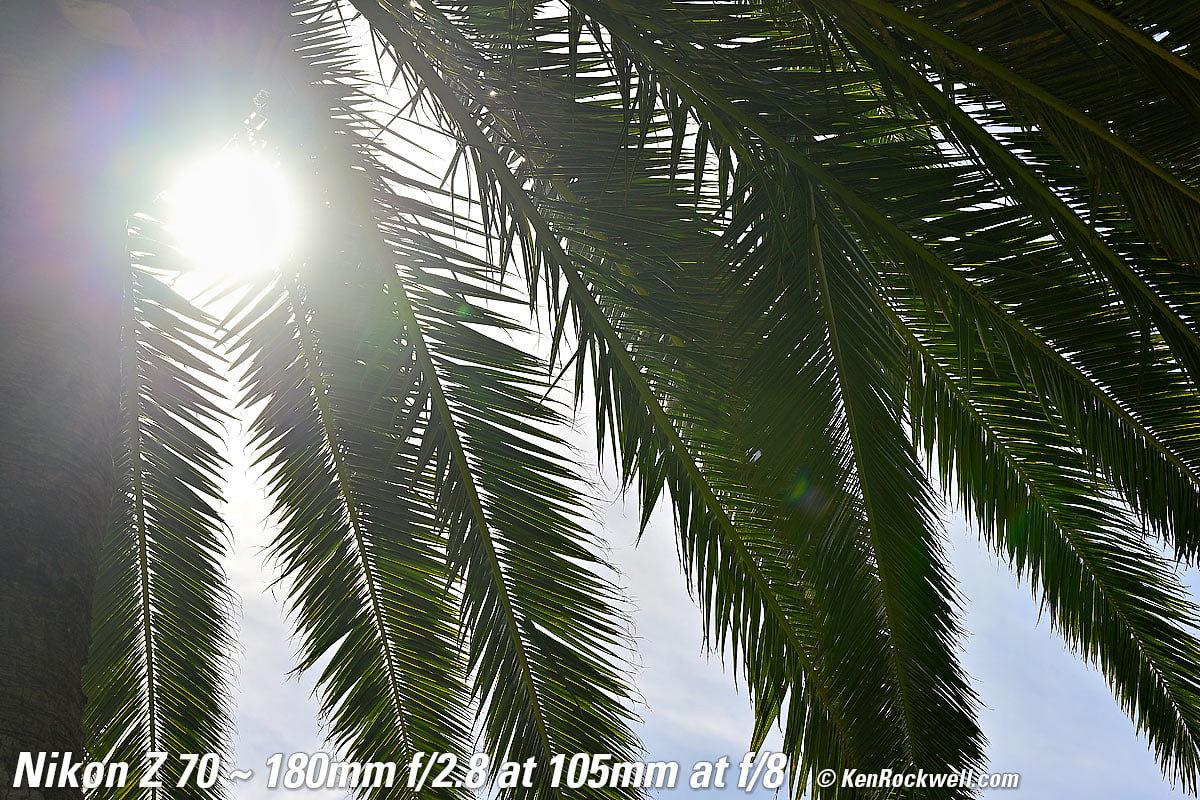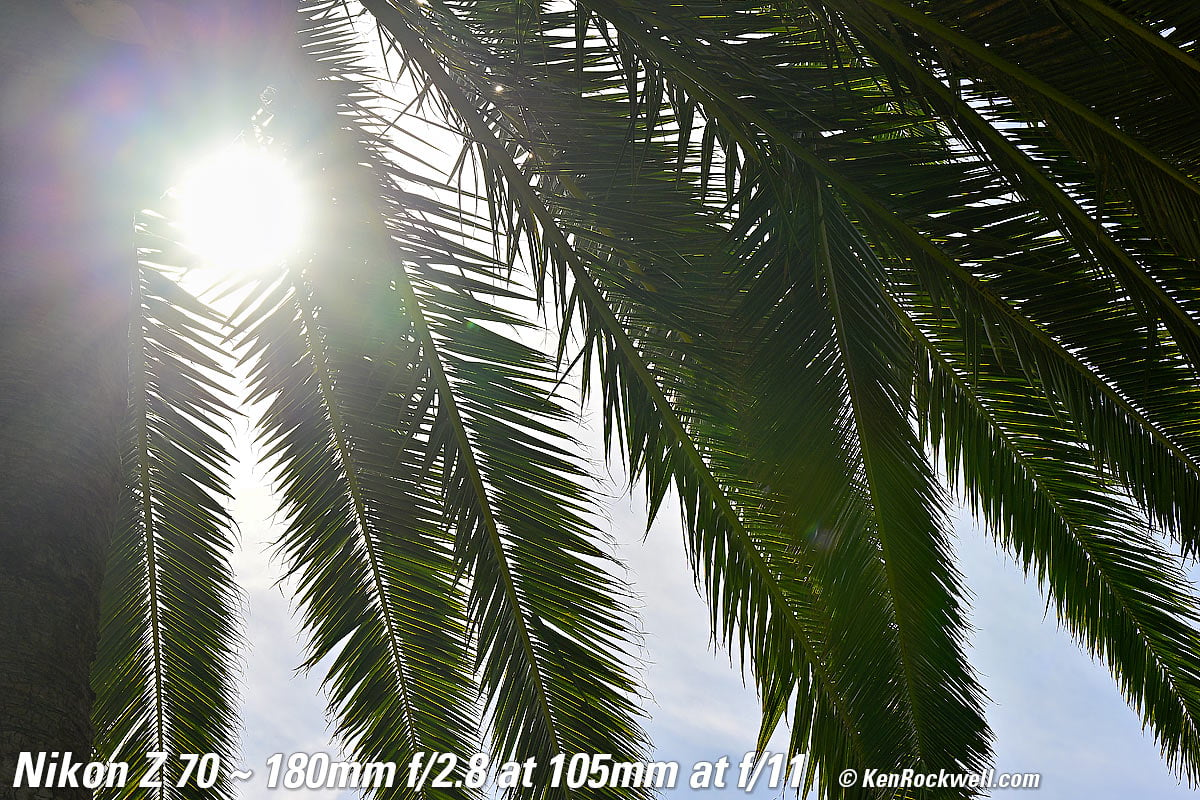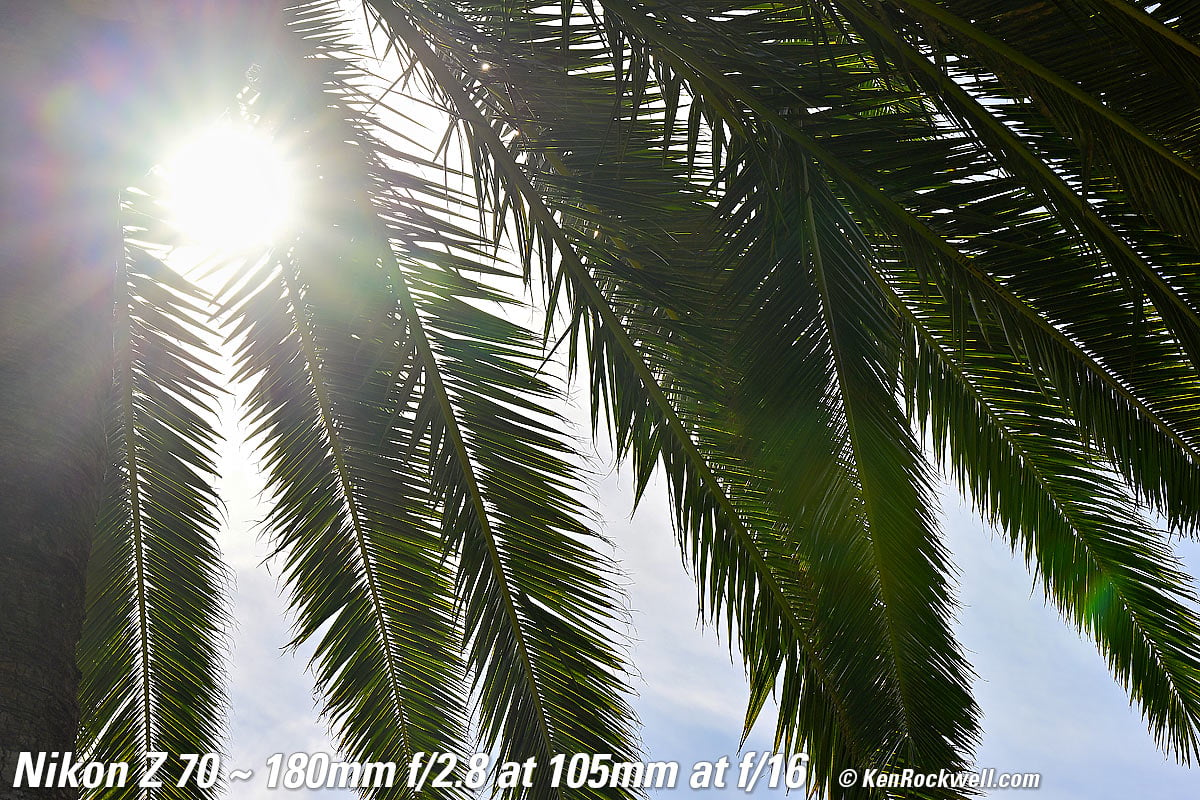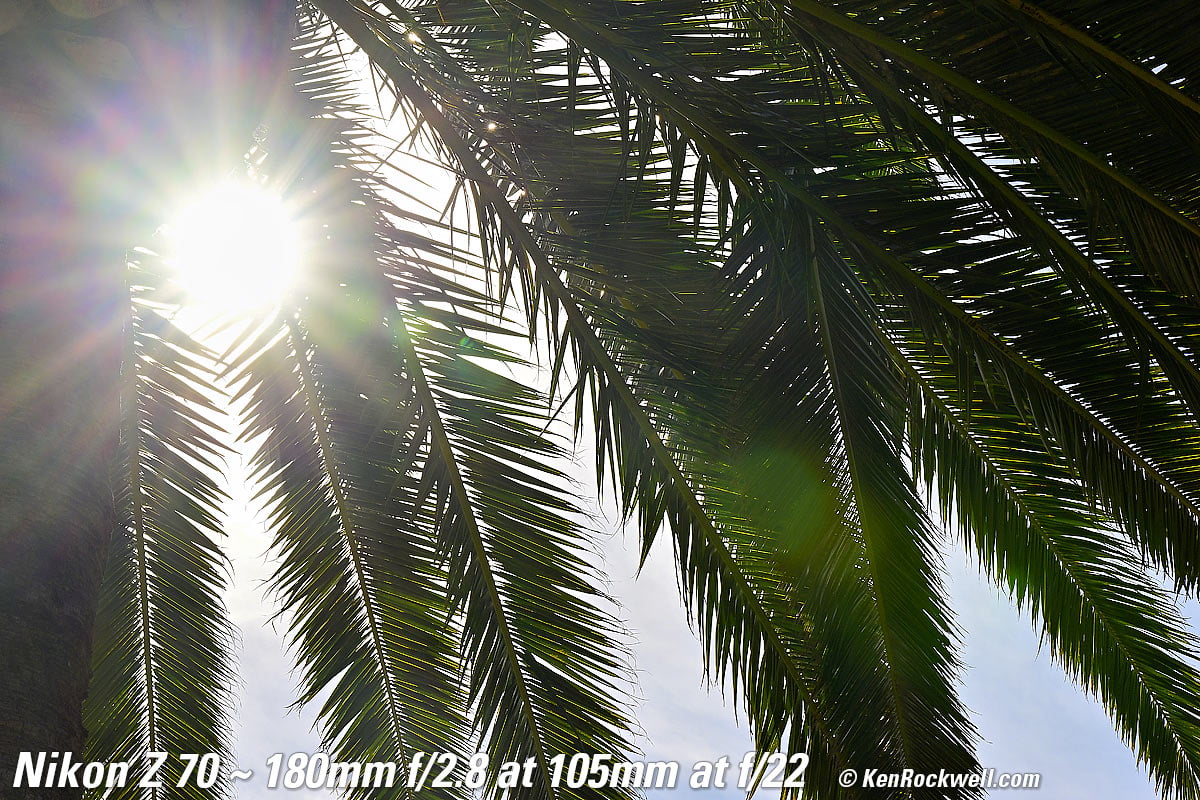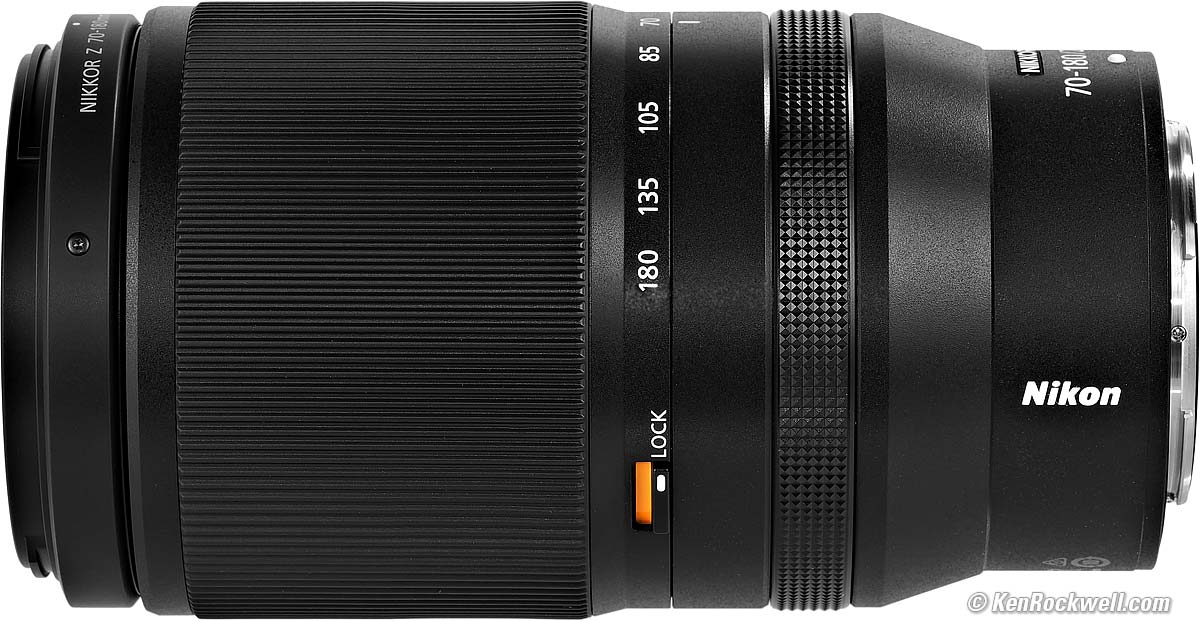Nikon Z 70-180mm f/2.8Full Frame (2023-)Great Optics and Ultralight, but no VR and no AF/MF switch.Sample Images Intro New Good Bad Missing Compatibility Specifications Performance Compared User's Guide Recommendations Z9 Z8 Z7 II Z6 II Zf Z7 Z6 Z5 Z fc Z50 Z30 Z System Z Lenses All Nikon Lenses Flash Nikon Z 70-180mm f/2.8 (67mm filters, 28.0 oz./795g, 0.9~2.8'/0.27~0.85m close focus, 0.48× macro ratio, $1,247). bigger. I got mine at B&H. I'd also get it at Adorama, at Amazon, or used at eBay if you know How to Win at eBay. This 100% all-content, junk-free website's biggest source of support is when you use those or any of these links to my personally approved sources I've used myself for way over 100 combined years when you get anything, regardless of the country in which you live — but I receive nothing for my efforts if you get it elsewhere. Nikon does not seal its boxes in any way, so never buy at retail or any other source not on my personally approved list since you'll have no way of knowing if you're missing accessories, getting a defective, damaged, returned, dropped, incomplete, gray-market, store demo or used lens — and all of my personally approved sources allow for 100% cash-back returns for at least 30 days if you don't love your new lens. I've used many of these sources since the 1970s because I can try it in my own hands and return it if I don't love it, and because they ship from secure remote warehouses where no one gets to touch your new lens before you do. Buy only from the approved sources I've used myself for decades for the best prices, service, return policies and selection.
January 2024 Better Pictures Nikon Mirrorless Mirrorless Lenses All Nikon Lenses Nikon Flash All Reviews Nikon Z 70-200mm f/2.8 VR (2020-today) Nikon 70-200mm f/2.8 FL (2016-today) All other Nikon f/2.8 70-200 and 80-200mm f/2.8 zooms compared (1978-today). Old Nikon AF Zoom-Micro NIKKOR 70-180mm f/4.5-5.6D ED (1997-2004).
Sample Images topSample Images Intro New Good Bad Missing Compatibility Specifications Performance Compared User's Guide Recommendations More samples throughout this review at Bokeh, Falloff, Macro, Spherochromatism and Sunstars. These are just snapshots; my real work is in my Gallery. These are all shot hand-held as BASIC ★ JPGs; no tripods, NORMAL or FINE JPGs or RAW files were used or needed. Packard, 8:52 AM, Saturday, 16 December 2023, Nikon Zf, Nikon Z 70-180mm f/2.8 at 125mm at f/4.5 at 1/320 at Auto ISO 100 (LV 12⅔), distracting elements erased with Luminar Neo's ERASE tool, dynamic optimization in Perfectly Clear (now sold as Radiant Photo). bigger or full resolution.
Orange BMW, 9:09 AM, Saturday, 16 December 2023, Nikon Zf, Nikon Z 70-180mm f/2.8 at 180mm wide-open at f/2.8 at 1/500 at Auto ISO 100 (LV 11.9), as shot. bigger.
Fletcher Cove Sunset, 4:37 PM, Monday, 18 December 2023. Vertical crop from horizontal Nikon Zf shot, Nikon Z 70-180mm f/2.8 at 81mm at f/6.3 at 1/1,000 at Auto ISO 110 (LV 15⅙), Radiant Photo. bigger.
2022 Mercedes S580, 8:59 AM, Tuesday, 16 January2024. Nikon Zf, Nikon Z 70-180mm f/2.8 at 125mm at f/5.6 hand-held at 1/160 at Auto ISO 110 (LV 12⅙), Skylum Luminar Neo to add warmth to a blustery day and add vignetting to emphasize the car. bigger or full resolution. Introduction topSample Images Intro New Good Bad Missing Compatibility Specifications Performance Compared User's Guide Recommendations
The Z 70-180mm f/2.8 is an ultralight and inexpensive fast tele zoom for Nikon's Z system. It's ideal for people, portraits and sports and action in dim light. It lacks VR, but VR doesn't help you when shooting moving things. It's a sharp, fast, lightweight lens; probably the lightest f/2.8 tele zoom made today. What's not to like other than the lack of an AF/MF switch and VR? It's mostly plastic and made in China, and because it's so light it's the lens I'd rather be carrying in the field than any of the pro model f/2.8 teles Nikon has made since the 1970s; its optics are just as good. Laugh all you want, but this cheap plastic thing is an ultrasharp and handy lens. 180mm is the same as 200mm as far as I'm concerned; I don't sweat the difference. This helps make it smaller, lighter and less expensive. It works with the TC 1.4× and 2× teleconverters:
Just turn the focus ring at any time for instant manual-focus override. I got my Z 70-180mm f/2.8 at B&H. I'd also get it at Adorama, at Amazon, or used at eBay if you know How to Win at eBay.
New intro top
Good intro top
Nikon Z 70-180mm f/2.8. bigger.
Bad intro top
Missing intro top
Compatibility topSample Images Intro New Good Bad Missing Compatibility Specifications Performance Compared User's Guide Recommendations
I got my Z 70-180mm f/2.8 at B&H. I'd also get it at Adorama, at Amazon, or used at eBay if you know How to Win at eBay.
This lens works only on Nikon's Z-series mirrorless cameras. It does not so much as even mount on any other camera.
It works with the TC 1.4× and 2× teleconverters.
Specifications topSample Images Intro New Good Bad Missing Compatibility Specifications Performance Compared User's Guide Recommendations
I got my Z 70-180mm f/2.8 at B&H. I'd also get it at Adorama, at Amazon, or used at eBay if you know How to Win at eBay.
Name specifications topNikon calls this the NIKKOR Z 70-180mm f/2.8:NIKKOR: Nikon's brand name for all their lenses. Z: For Nikon's mirrorless cameras.
It also has: AF-P: Stepper (Pulse) autofocus motor: silent and ultra fast. Aspherical: Specially curved glass elements for sharper pictures. D: Couples distance information to the 3D Matrix Meter. ED and Super ED: Magic Extra-low Dispersion glass for reduced secondary chromatic aberration. IF: Internal focusing; nothing moves externally as focused. ∅67: 67mm filter thread.
Optics specifications topNikon Z 70-180mm f/2.8 internal optical construction. ED, Super ED and Aspherical elements. bigger. 19 elements in 14 groups. 5 ED extra-low dispersion elements, which helps reduce secondary axial chromatic aberration. 1 Super ED extra-low dispersion element, which helps reduce secondary axial chromatic aberration. 3 Aspherical elements. Pumper zoom; the front section extends as zoomed to 180mm. Internal focussing; nothing external moves as focused. Nikon Super Integrated multicoating (SIC). Fluorine front coating to resist crud.
Diaphragm specifications topNikon Z 70-180mm f/2.8. bigger. 9 rounded blades. Electronically actuated. Stops down to f/22.
Filters specifications top
Angle of View specifications topOn Full Frame FX34⅓º ~ 13⅔º diagonal.
On APC-S DX22⅚º ~ 9º diagonal. See also Crop Factor.
Autofocus specifications topNo external movement as focussed, so no air or dust is sucked in.
Focus Scale specifications topNo. Not on lens, but may be displayed in-camera.
Infinity Focus Stop specifications topNo. You have to focus somehow to get precise focus at infinity, just like at every other distance.
Depth of Field Scale specifications topNo. Not on lens, but may be displayed in-camera.
Infrared Focus Index specifications topNo.
Close Focus (distance from subject to image plane) specifications top0.9' (10.6" or 0.27 meters) at 70mm. 2¾' (33½" or 0.85 meters) at 180mm.
Maximum Reproduction Ratio specifications top1:2.1 (0.48 ×) at 70mm. Much less at 180mm.
Reproduction Ratio Scale specifications topNo.
Image Stabilizer specifications topNONE, but works with in-camera stabilization if you have it.
Caps specifications topLC-67B 67 mm snap-on front cap and LF-N1 Z-mount rear cap included.
Hood specifications topHB-113 hood, included. It's too short to do much of anything other than keep your fingers out of the lens.
"Case" specifications topNikon CL-C1 Lens "Case". bigger. Nikon claims it includes a case, but it's only a CL-C1 cloth bag. A tube sock works better. I love my Think Tank Retrospective bags for carrying this lens with my Z system.
Size specifications top3.23" ø maximum diameter × 5.94" extension from flange. 83.5 mm ø maximum diameter × 151 mm extension from flange.
Weight specifications top28.0 oz. (795g).
Quality specifications topNikon Z 70-180mm f/2.8. bigger. Production dumped to China, not made domestically in Japan.
Announced specifications topWednesday, 21 June 2023 at 12:04 AM NYC time.
Promised for specifications topMid-July 2023.
Included specifications topLC-67B 67 mm snap-on front cap. LF-N1 Z-mount rear cap. CL-C1 sack.
Nikon's Model Number specifications top20120.
Price, U. S. A. specifications topJanuary 2024$1,247 at B&H, at Adorama or at Amazon. About $1,100 used if you know How to Win at eBay.
June 2023$1,247 at B&H and at Adorama.
Performance topSample Images Intro New Good Bad Missing Compatibility Specifications Performance Compared User's Guide Recommendations
Overall Autofocus Manual Focus Breathing Bokeh Distortion Ergonomics Falloff Filters Flare & Ghosts Lateral Color Fringes Lens Corrections Macro Mechanics Sharpness Spherochromatism Stabilization Sunstars Teleconverters Tripod Collar Weather Sealing
I got my Z 70-180mm f/2.8 at B&H. I'd also get it at Adorama, at Amazon, or used at eBay if you know How to Win at eBay.
Overall performance topThis is a good, sharp, lightweight and inexpensive lens.
Autofocus performance topAutofocus is reasonably fast and almost completely silent. It's not instantaneous, but pretty darn fast for focussing from near to far. If you're in a quiet area you may hear a very slight whine as it focuses, otherwise it's silent. Bravo!
Manual Focus performance topManual focusing is entirely electronic; the manual focus ring (the thin one at the back) isn't connected to anything other than a digital encoder. Just grab this electronic manual focus ring for instant manual-focus override anytime the camera is awake. Better than any other brand, even if you're in AF-C and grab the manual-focus ring, it just swaps to manual focus instantly and stays in manual focus. Other brands will try to fight you for focus if you're in continuous AF, while this lens just does what you tell it to do. Bravo! There is no AF/MF switch; you have to set this in a menu if you want to lock it into manual-only mode. Boo!
Focus Breathing performance topFocus breathing is the image changing size as focused in and out. It's important to cinematographers that the image not breathe because it looks funny if the image changes size as focus gets pulled back and forth between actors. If the lens does this, the image "breathes" by growing and contracting slightly as the dialog goes back and forth. The image from this 70-180mm grows a bit as focused more closely, but you won't see it at larger apertures because it's less than the amount by which the blur circles grow and contract. It's relatively subtle.
Bokeh performance topBokeh, the feel, character or quality of out-of-focus areas as opposed to how far out of focus they are, is excellent. Out of focus backgrounds just melt away. Here are photos from headshot distance wide-open. I'm focused on the DAVIS logo. Click either for the © camera-original file: Made-in-U. S. A. Davis 6250 professional weather station (now replaced by model 6357), 17 January 2024. Nikon Zf, Nikon Z 70-180mm f/2.8 at 1/2,500 and 1/2,000 at Auto ISO 100, +0.7 stops exposure compensation (LV 14). Click either for the camera-original © files. As always, if you want to throw the background as far out of focus as possible, shoot at 180mm at f/2.8 and get as close as possible.
Distortion performance topThe Nikon Z 70~180mm f/2.8 has no distortion as-shot, because Nikon's Z cameras won't let us turn off the automatic in-camera distortion correction! I wasn't able to measure, much less see, any distortion at all in corrected images. If you shoot raw data rather than JPG images, whatever software you use to create visible images from raw data may or may not correct the distortion as is done in-camera as JPGs. You're on your own there; I don't bother with raw data. These aren't facts or specifications, they are the results of my research that requires hours of photography and calculations on the resulting data.
© 2024 KenRockwell.com. All rights reserved.
Ergonomics performance top
There's no AF/MF switch, which I find to be a big pain in the neck because I now have to switch this in menus rather than just flipping a switch. There's no switch for in-camera Image Stabilization; you also have to set this in a menu if your camera has in-body stabilization. Otherwise, ergonomics are easy: the big zoom ring is a real direct mechanical zoom ring and the skinny rear focus ring is always active, bravo!
Falloff performance topFalloff is invisible, at least with correction left at its default of NORMAL. If you shoot raw data rather than JPG images, whatever software you use to create visible images from raw data may or may not correct this as is done in-camera as JPGs. You're on your own there; I don't bother with raw data. I've greatly exaggerated the falloff by shooting a gray field and placing these on a gray background; it will not look this bad in actual photos of real things:
Even though 180mm wide-open at f/2.8 seems like there's a little falloff, it's so minor I doubt you'll notice it in actual shooting. If you go out of your way to turn off correction and then go looking for it here, it's still minor. You might notice a little at 180mm at f/2.8 with corrections off, but otherwise even with no correction you're not going to see any in actual photos of real things:
Filters, use with performance topThere's no need for thin filters. I can stack several standard 67mm filters with no vignetting at any setting on full-frame. Go ahead and use your standard rotating polarizer and grad filters.
Flare & Ghosts performance topFlare and ghosts aren't a problem. There are few if any. See examples at Sunstars.
Lateral Color Fringes performance topThere are no color fringes as shot on Nikon cameras as JPG, which by default correct for any that may be there. If you shoot raw data and then use non-manufacturer software to process that data into images then there is the possibility that there might be some. Beats me; I don't bother with raw, and my photos look OK to me.
Lens Corrections performance topThe Z9, Z8, Z7 II, Z6 II, Zf, Z7, Z6, Z5, Z fc, Z50 and Z30 correct for any or all of distortion, diffraction and falloff (vignette control). Distortion control cannot be turned off, while diffraction and falloff (vignette control) correction can be turned ON or OFF. The Z9, Z8, Z7 II, Z6 II, Zf, Z7, Z6, Z5, Z fc, Z50 and Z30 always correct for lateral color fringes (lateral chromatic aberration). This is part of Nikon's secret sauce and never appears in any menu. If you shoot raw data rather than JPG images, whatever software you use to create visible images from raw data may or may not correct these as is done in-camera as JPGs. You're on your own there; I don't bother with raw data.
Macro Performance performance topIt gets closer at the 70mm setting than at the 180mm setting. It gets so much closer that the largest image is reached at 70mm!
At 70mmIf you can remember to zoom out to 70mm you can get very close: half life-size at the image sensor or a 0.48× macro ratio: Casio G-Shock Solar Atomic Watch at close-focus distance, 17 January 2024. Nikon Zf, Nikon Z 70-180mm f/2.8 at 70mm wide-open at f/2.8 at 1/1,600 at Auto ISO 100, +0.7 stops exposure compensation (LV 13.6). bigger or camera-original © file. It gets super close at 70mm, but it's not that sharp wide-open at f/2.8: 1,200 × 900 pixel (5× magnification) crop from above. bigger or camera-original © file. If this 1,200 × 900 pixel crop is about 3" (7.5cm) wide on your screen, then the complete image printed at this same large magnification would be about 10 × 15" (25 × 38cm). If this 1,200 × 900 pixel crop are about 6" (15cm) wide on your screen, then the complete image printed at this same extreme magnification would be about 20 × 30" (50 × 75cm). If this 1,200 × 900 pixel crop are about 12" (30cm) wide on your screen, then the complete image printed at this same insanely high magnification would be about 40 × 60" (1 × 1.5 meters). Click any for the camera-original © files. Stopped down it's sharp, and of course you need to stop down to get anything in focus as all lenses have about zero depth of field at macro distances.
At 180mmIt gets close enough at 180mm, but not as close as at 70mm, but it's sharper and I prefer the perspective rendering and greater working distance: Casio G-Shock Solar Atomic Watch at close-focus distance, 17 January 2024. Nikon Zf, Nikon Z 70-180mm f/2.8 at 180mm wide-open at f/2.8 at 1/2,500 at Auto ISO 100. +0.7 stops exposure compensation (LV 14.3). bigger or camera-original © file. It's much sharper wide-open than at 70mm (of course stop down for sharper results and depth of field at these distances): 1,200 × 900 pixel (5× magnification) crop from above. bigger or camera-original © file. If this 1,200 × 900 pixel crop is about 3" (7.5cm) wide on your screen, then the complete image printed at this same large magnification would be about 10 × 15" (25 × 38cm). If this 1,200 × 900 pixel crop are about 6" (15cm) wide on your screen, then the complete image printed at this same extreme magnification would be about 20 × 30" (50 × 75cm). If this 1,200 × 900 pixel crop are about 12" (30cm) wide on your screen, then the complete image printed at this same insanely high magnification would be about 40 × 60" (1 × 1.5 meters). Click any for the camera-original © files.
Mechanical Quality performance topNikon Z 70-180mm f/2.8. bigger. This is a mostly plastic-barreled lens with glass elements and a metal mount. FinishBlack plastic.
HoodPlastic bayonet.
Front BumperNone.
Filter ThreadsPlastic.
Hood Bayonet MountPlastic.
Gold ED BandNone.
Front Barrel ExteriorPlastic.
Zoom RingRubber-covered metal and plastic.
Mid Barrel ExteriorPlastic.
Focus RingHard plastic.
Slide SwitchesNone.
Rear Barrel ExteriorPlastic.
IdentityPrinted around front of barrel, also printed on top of barrel.
InternalsSeems like plastic and metal.
Dust Gasket at MountNo, but the plastic barrel drops over the mount so it does the same thing.
MountChromed metal.
MarkingsPainted.
Serial NumberLaser engraved in black-on-black on bottom of barrel: Nikon Z 70-180mm f/2.8. bigger.
Date CodeNone found.
Noises When ShakenMild clicking from the diaphragm blades.
Made inMade in China.
Sharpness performance topLens sharpness has nothing to do with picture sharpness; every lens made in the past 100 years is more than sharp enough to make super-sharp pictures if you know what you're doing. The only limitation to picture sharpness is your skill as a photographer. It's the least talented who spend the most time worrying about lens sharpness and blame crummy pictures on their equipment rather than themselves. Skilled photographers make great images with whatever camera is in their hands; I've made some of my best images of all time with an irreparably broken camera! Most pixels are thrown away before you see them, but camera makers don't want you to know that. If you're not getting ultra-sharp pictures with this, be sure not to shoot at f/11 or smaller where all lenses are softer due to diffraction, always shoot at ISO 100 or below because cameras become softer at ISO 200 and above, avoid shooting across long distances over land which can lead to atmospheric heat shimmer, be sure everything is in perfect focus, set your camera's sharpening as you want it (I set mine to the maximum) and be sure nothing is moving, either camera or subject. If you want to ensure a soft image with any lens, shoot at f/16 or smaller at ISO 1,600 or above at default sharpening in daylight of subjects at differing distances in the same image. People worry waaaaay too much about lens sharpness. It's not 1968 anymore when lenses often weren't that sharp and there could be significant differences among them; ever since about 2010 all new lenses are all pretty much equally fantastic. This lens is very sharp corner-to corner at every aperture, limited of course by diffraction at f/16. If I had to look too closely the far corners might be just a little softer at f/2.8, but I can't really see that. Laugh all you want, but this cheap plastic thing is an ultrasharp lens:
Nikon's MTF charts at 10 cyc/mm and 30 cyc/mm.
Spherochromatism performance topSpherochromatism, also called secondary spherical chromatic aberration or "color bokeh," is an advanced form of spherical and chromatic aberration in a different dimension than lateral chromatic aberration. It happens mostly in fast normal and tele lenses when spherical aberration at the ends of the color spectrum are corrected differently than in the middle of the spectrum. Spherochromatism can cause colored fringes on out-of-focus highlights, usually seen as green fringes on backgrounds and magenta fringes on foregrounds. Spherochromatism is common in fast lenses of moderate focal length when shooting contrasty items at full aperture. It goes away as stopped down. It has minor spherochromatism: Mondaine A132.30348.11SBB at close-focus distance at , January 2024. bigger or camera-original © file.
1,200 × 900 pixel (5× magnification) crop from above. bigger or camera-original © file. If this 1,200 × 900 pixel crop is about 3" (7.5cm) wide on your screen, then the complete image printed at this same large magnification would be about 10 × 15" (25 × 38cm). If this 1,200 × 900 pixel crop are about 6" (15cm) wide on your screen, then the complete image printed at this same extreme magnification would be about 20 × 30" (50 × 75cm). If this 1,200 × 900 pixel crop are about 12" (30cm) wide on your screen, then the complete image printed at this same insanely high magnification would be about 40 × 60" (1 × 1.5 meters).
Image Stabilization (VR) performance topIt has NO Optical Image Stabilization (OIS, IS or VR (Vibration Reduction)). I'd only use this lens on a body with built-in stabilization.
Sunstars performance topWith a 9-bladed rounded diaphragm, I don't get much of anything for sunstars on brilliant points of light except at f/22, where I can get soft 18-point stars if I really work at it. Ignore the crazy rainbow effects at small apertures; these are sensor artifacts caused by taking a picture directly of the sun and exposing for the dark underside of a huge palm tree, and using that same palm tree to hide the sky to accentuate the stars. Click any to enlarge: Click any to enlarge.
Teleconverters performance topNikon says it works with the TC 1.4× and 2× teleconverters:
While it's great to have the freedom to use teleconverters, I stopped using teleconverters with my f/2.8 teles back around 2003 when I got my first 80-400mm VR which covered the full range from 80 to 400mm — without having to stop and jam a teleconverter in and out of my rig. Today I prefer the Z 100-400mm over any of the 70-200mm lenses and converters. For me it's critical to get to whatever focal length I need with a twist of the wrist. The Z 100-400mm is a big, pro-level lens. If you want something as small and light and high performance as this Z 70-180mm, switch to Canon and get the sharp, lightweight and inexpensive RF 100-400mm IS USM, for which there is no equivalent in the Nikon system. Sorry 😢.
Tripod Collar performance topThis lens is so light, there's no need for a tripod collar 😛.
Weather Sealing performance topThis lens claims weather sealing, but personally I don't worry even if it had none. If it's raining, I use an umbrella.
Compared topSample Images Intro New Good Bad Missing Compatibility Specifications Performance Compared User's Guide Recommendations I got my Z 70-180mm f/2.8 at B&H. I'd also get it at Adorama, at Amazon, or used at eBay if you know How to Win at eBay. Except for lacking VR (which doesn't help for sports or action), I'd much rather have this lighter lens than the huge Z 70-200/2.8 VR which costs twice as much. Personally I don't need f/2.8 because I'm not trying to shoot action in low light, so I prefer the all-in-one Z 24-200mm VR. The Z 24-200mm VR works fine for occasional indoor sports if you don't mind using higher ISOs around 10,000, and gives sharper results for nature and landscape in dim light because there is a lot more depth of field at smaller apertures with VR than at f/2.8 without VR.
* You'll be depending solely on your in-camera VR.
User's Guide topSample Images Intro New Good Bad Missing Compatibility Specifications Performance Compared User's Guide Recommendations
I got my Z 70-180mm f/2.8 at B&H. I'd also get it at Adorama, at Amazon, or used at eBay if you know How to Win at eBay.
AF - MF Switch user's guide topThere's no AF/MF switch; you have to set this in a menu. Use whatever Fn or other button is assigned to set Focus Mode, or Focus Mode is also usually among the options at the 𝒊 button.
Zoom Lock user's guide topThere's a little slider to lock the lens at 70mm. It shows in orange when it's locked: Nikon Z 70-180mm f/2.8. bigger.
Recommendations topSample Images Intro New Good Bad Missing Compatibility Specifications Performance Compared User's Guide Recommendations I got my Z 70-180mm f/2.8 at B&H. I'd also get it at Adorama, at Amazon, or used at eBay if you know How to Win at eBay. This is a great little lens, however Nikon makes so many other lenses that which is best for you depends on what you're doing. This 70-180mm f/2.8 is best for people who need a fast, dedicated and lightweight tele and don't care about VR. It's ideal for most things if your camera has stabilization, and even if not, definitely good for low-light sports even without VR. I prefer this 70-180mm f/2.8 over Nikon's other 70-200mm lenses because it weighs so much less; it's a joy to take out and use and never has me leaving it back in my car. This 70-180mm even fits in my jacket pocket! For real-world landscapes, I prefer the Z 24-200 VR because it's small, covers the range of two zooms and it's sharp, and has VR. I use a clear (UV) protective filter instead of a cap (exactly like an iPhone) so I'm always ready to shoot instantly. I only use a cap when I throw this in a bag with other gear without padding — which is never. The UV filter never gets in the way, and never gets lost, either. The very best protective filter is the nearly indestructible Hoya multicoated HD3 67mm UV which uses hardened glass and repels dirt and fingerprints. For less money, the Nikon 67mm NC (No Color/Neutral Clear), Hoya 67mm NXT Plus UV and Hoya 67mm UV MC are all excellent filters, but the Hoya HD3 is the toughest and longest lasting with abuse. If I was working in nasty, dirty areas, I'd use an uncoated 67mm Tiffen UV filter instead. Uncoated filters are much easier to clean, but more prone to ghosting. Filters last a lifetime, so you may as well get the best. The Hoya HD3 stays cleaner than the others since it repels oil and dirt. All these filters are just as sharp and take the same pictures, the difference is how much abuse they'll take and stay clean and stay in one piece. Since filters last a lifetime or more, there's no reason not to buy the best as it will last you for the next 50 years. Filters aren't throwaways like digital cameras which we replace every few years, like it or not. I'm still using filters I bought back in the 1970s! The Hoya HD3 stays cleaner than the others since it repels oil and dirt, and you'll be using it long after you've thrown this lens away in 50 years. I got my Z 70-180mm f/2.8 at B&H. I'd also get it at Adorama, at Amazon, or used at eBay if you know How to Win at eBay. This 100% all-content, junk-free website's biggest source of support is when you use those or any of these links to my personally approved sources I've used myself for way over 100 combined years when you get anything, regardless of the country in which you live — but I receive nothing for my efforts if you get it elsewhere. Nikon does not seal its boxes in any way, so never buy at retail or any other source not on my personally approved list since you'll have no way of knowing if you're missing accessories, getting a defective, damaged, returned, dropped, incomplete, gray-market, store demo or used lens — and all of my personally approved sources allow for 100% cash-back returns for at least 30 days if you don't love your new lens. I've used many of these sources since the 1970s because I can try it in my own hands and return it if I don't love it, and because they ship from secure remote warehouses where no one gets to touch your new lens before you do. Buy only from the approved sources I've used myself for decades for the best prices, service, return policies and selection. Thanks for helping me help you! Ken.
© Ken Rockwell. All rights reserved. Tous droits réservés. Alle Rechte vorbehalten. Alla rättigheter förbehållna. Toate drepturile rezervate. Ken Rockwell® is a registered trademark.
Help Me Help You topI support my growing family through this website, as crazy as it might seem. The biggest help is when you use any of these links when you get anything. It costs you nothing, and is this site's, and thus my family's, biggest source of support. These places always have the best prices and service, which is why I've used them since before this website existed. I recommend them all personally. If you find this page as helpful as a book you might have had to buy or a workshop you may have had to take, feel free to help me continue helping everyone. If you've gotten your gear through one of my links or helped otherwise, you're family. It's great people like you who allow me to keep adding to this site full-time. Thanks! If you haven't helped yet, please do, and consider helping me with a gift of $5.00. As this page is copyrighted and formally registered, it is unlawful to make copies, especially in the form of printouts for personal use. If you wish to make a printout for personal use, you are granted one-time permission only if you PayPal me $5.00 per printout or part thereof. Thank you! Thanks for reading!
Ken.
|
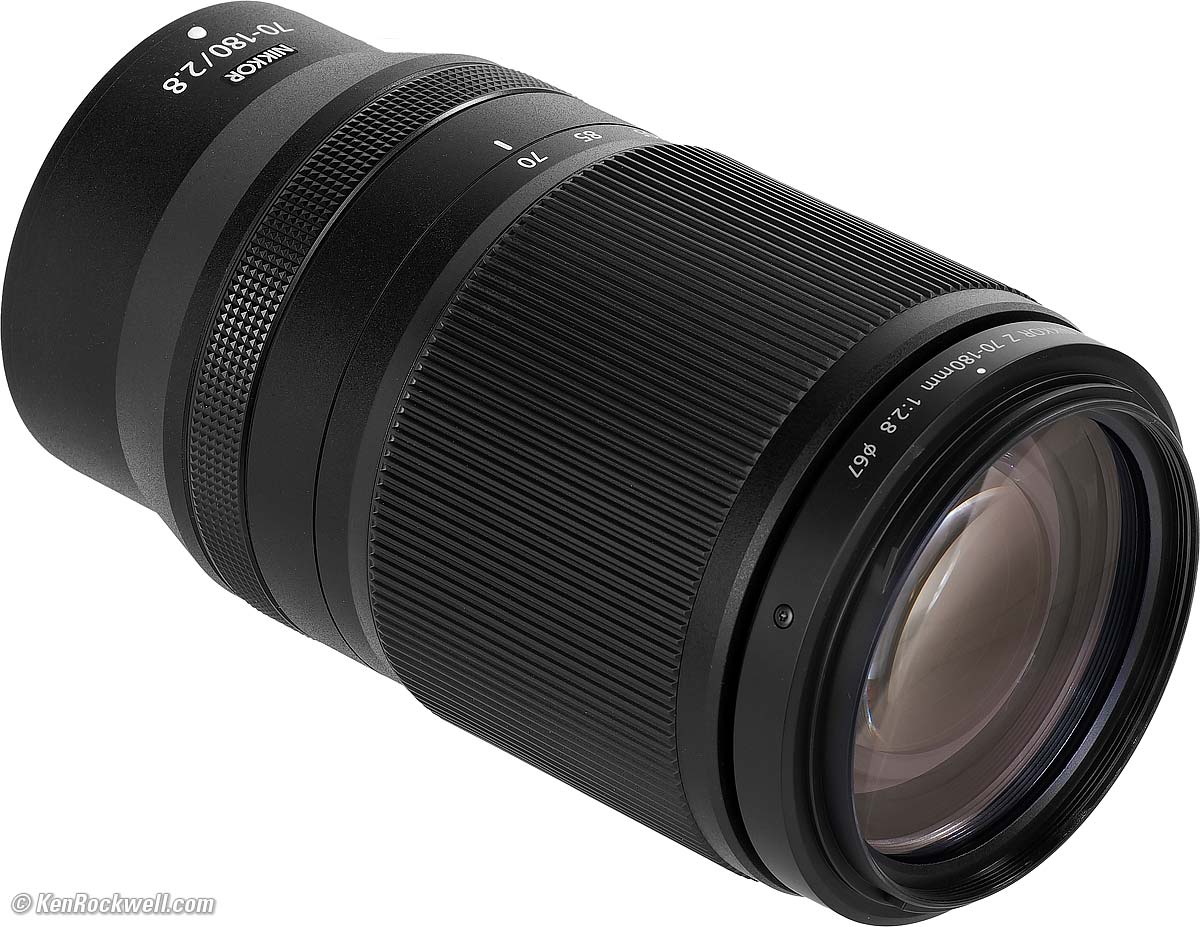
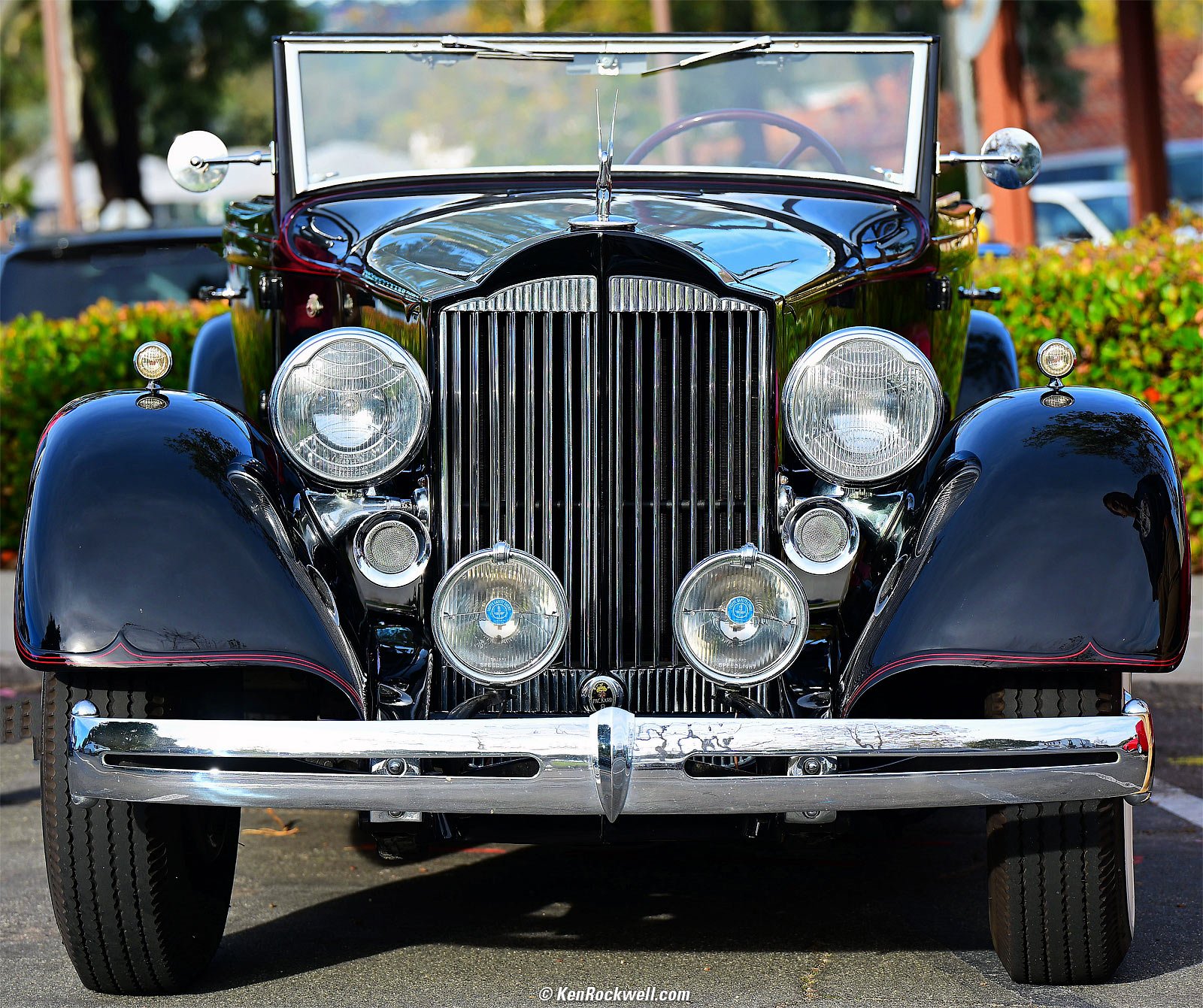
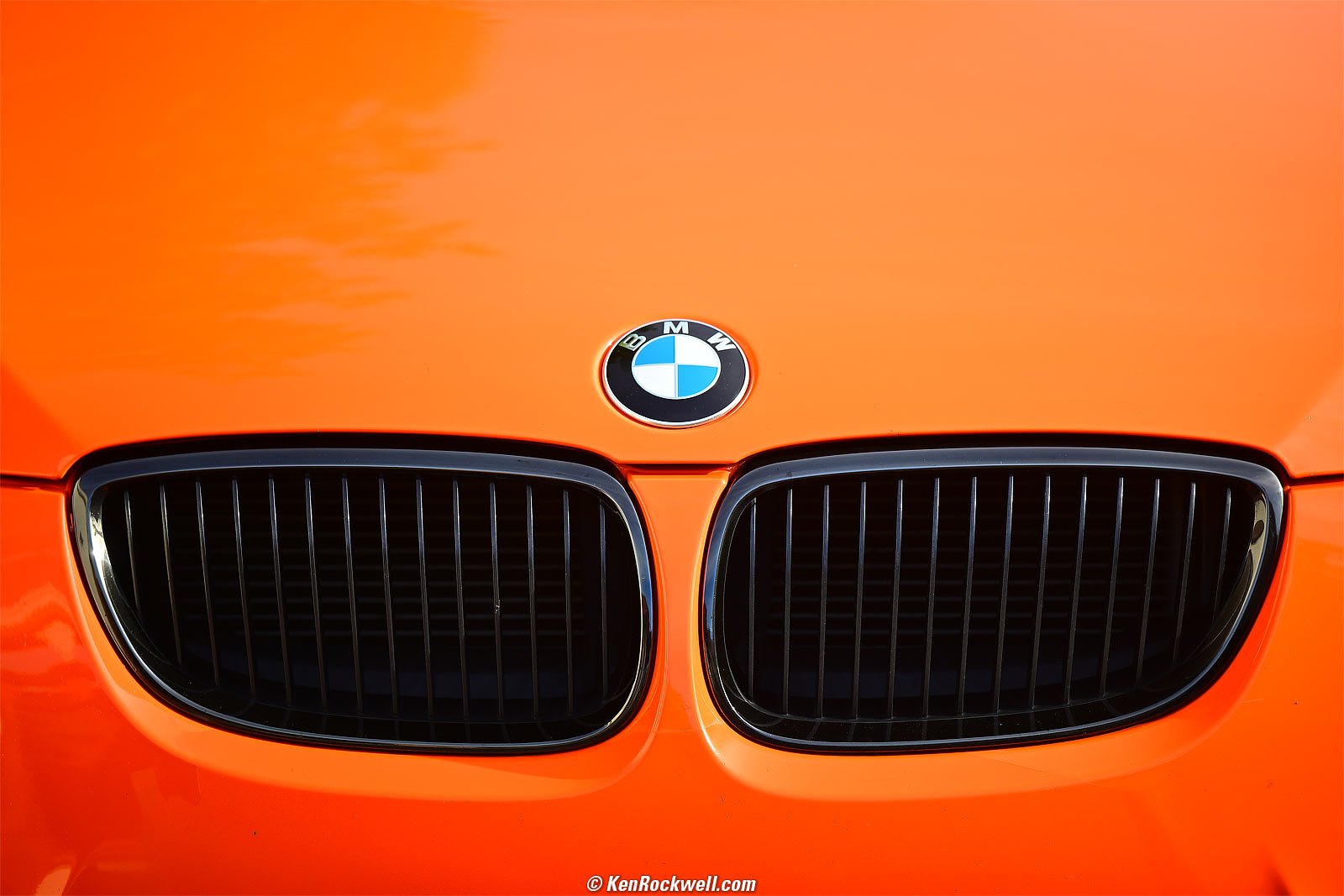
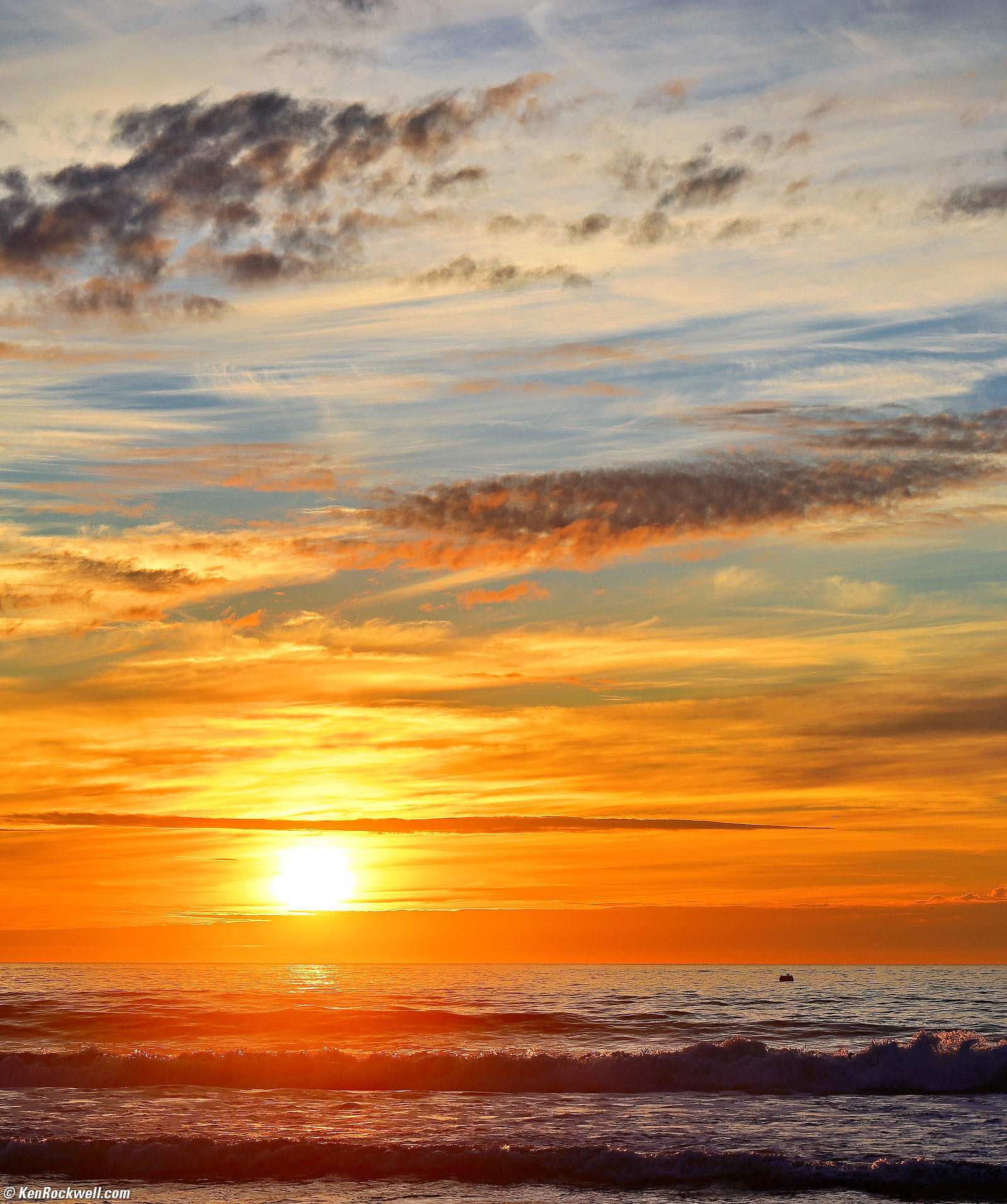
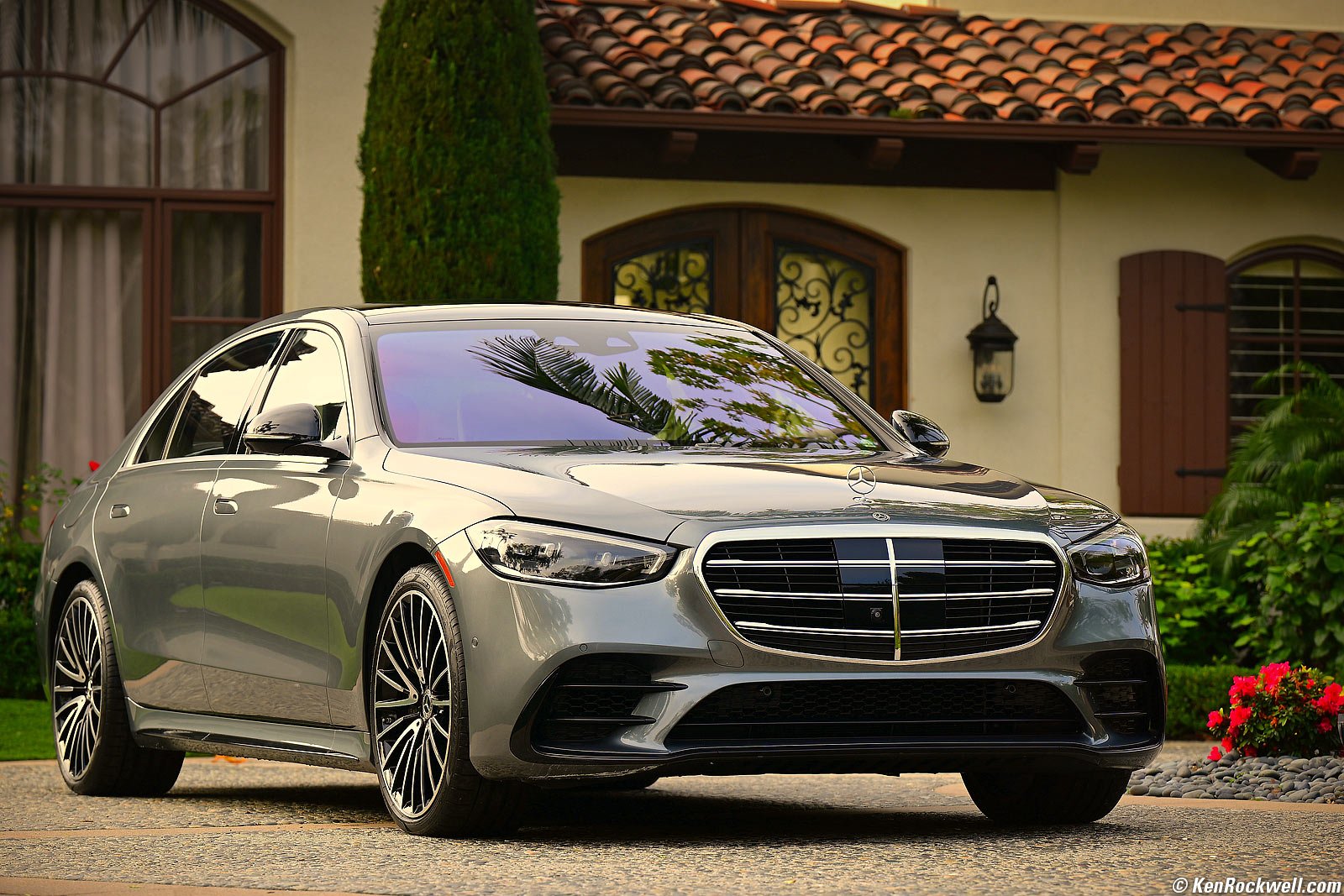





 Nikon's first-ever ultralight f/2.8 tele zoom.
Nikon's first-ever ultralight f/2.8 tele zoom.  Probably the world's lightest full-frame f/2.8 telephoto zoom.
Probably the world's lightest full-frame f/2.8 telephoto zoom.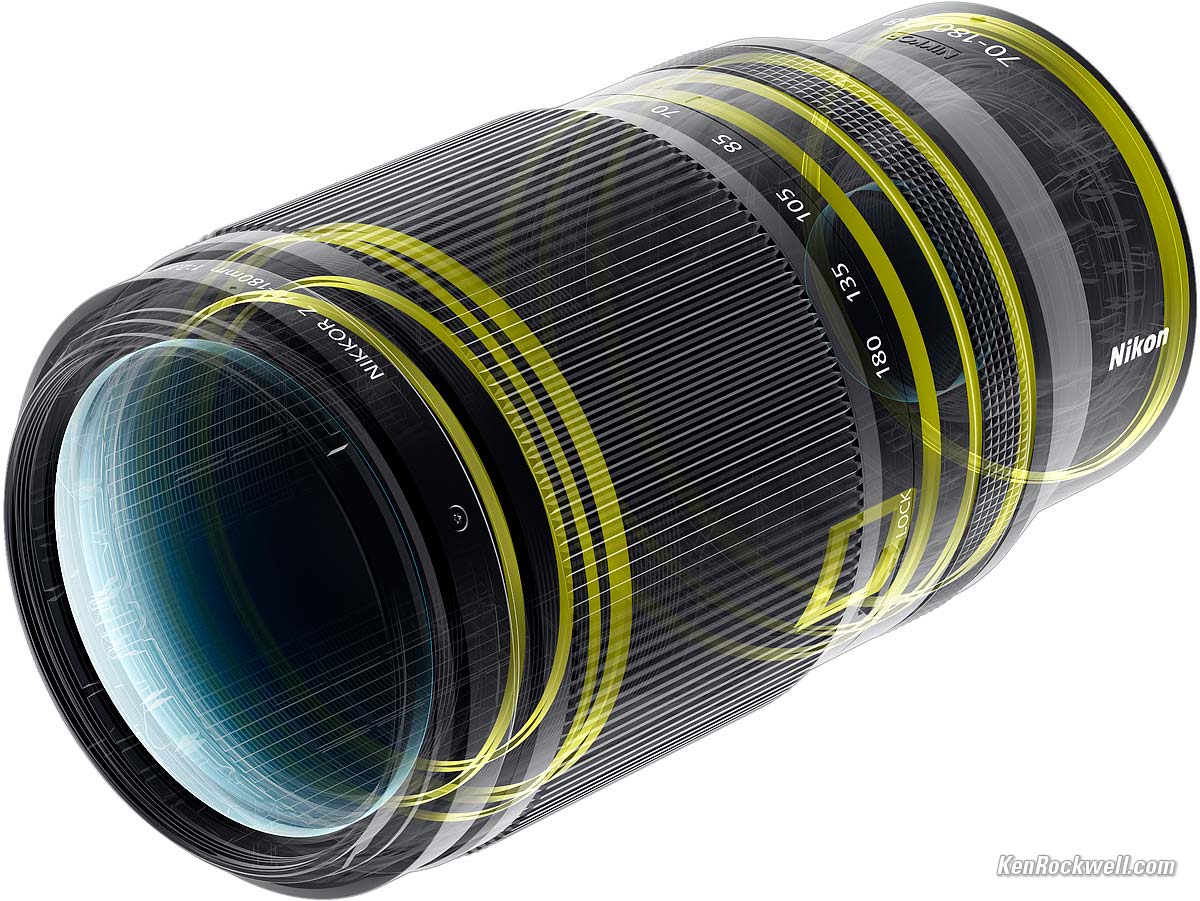
 No AF/MF switch; we have to
No AF/MF switch; we have to  No AF/MF switch.
No AF/MF switch.
